Reviewing D&D Monsters - 5E Monster Manual, Goblins to Kenku
Written on: 11月 04, 2019
Reviewing D&D Monsters - 5E Monster Manual, Goblins to Kenku - Hi friends, I hope you are all in good healthkanakoroku, In the article you are reading this time with the title Reviewing D&D Monsters - 5E Monster Manual, Goblins to Kenku, We have prepared this article well for you to read and take information in it. hopefully the contents of the post
Artikel Dungeons & Dragons,
Artikel Game,
Artikel Reviewing Monsters, what we write you can understand. ok, happy reading.
Title : Reviewing D&D Monsters - 5E Monster Manual, Goblins to Kenku
link : Reviewing D&D Monsters - 5E Monster Manual, Goblins to Kenku
Click here for the previous part, covering Fomorians to Gnolls.
Click here for the next part, covering Kobolds to Mimics.
Click here for the index.
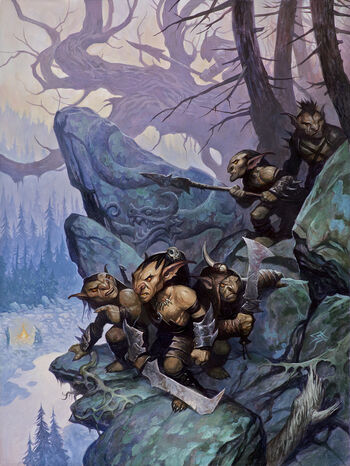
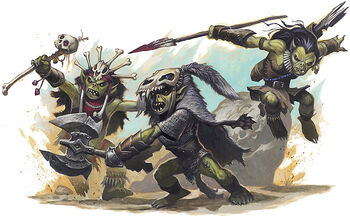
Goblin
And here we go with one of the more iconic monsters in modern fantasy, the goblin. And it's interesting just how many different types of goblins there are in modern fantasy, and how much D&D's goblins... actually don't visually look like most of the green-skinned crazy goblins seen in many modern fiction! D&D's goblins have relatively consistently just look like monstrous little midget humans with fleshy skin colouration, whereas most video games tend to feature green-skinned goblins who are more entertainingly psychotic than just straight-out evil. You can blame Warhammer for that depiction of goblins, which are green-skinned, capricious, destructive and more just generically 'chaotic' than actually evil, and then franchises like Magic: The Gathering, the Warcraft franchise and Pathfinder latched onto this depiction wholeheartedly. I love the goblins, but it's hard to really say that D&D's goblins are super-duper interesting. They're just evil, nasty little cave-dwelling scumbags that are ill-mannered, attack villages, and serve as general nuisances for most adventurers. Sometimes they come with their larger, far more dangerous cousins, the two other goblinoid races -- the brutish Bugbears, and the smarter, more warlike Hobgoblins. The second bestiary book in 5th Edition, Volo's Guide to Monsters, throws in goblins as one of the monster races you could make into a player race, but honestly, again, standard D&D goblins are pretty boring.
And... y'know, that's all about it for goblins. In most of the D&D material I've seen, they're just kinda there, as evil, greedy, sneaky bastards. Most D&D streams and playthroughs tend to basically ignore this and adapt something more akin to a mixture of Magic, Warcraft and Warhammer goblins. A race of greedy, crazy bastards who love tinkering and creating destructive and potentially self-harming contraptions. D&D-based comics like Order of the Stick and Goblins tend to give the goblins a lot more intelligence and make them out to be misunderstood due to their different culture. Pathfinder basically takes the 'psychotic' and 'lovably stupid' and ramps it up to eleven, making them particularly delightfully psychotic little shits who love fire, don't really understand mortality, and fear writing (writing takes the words out of your head!) I genuinely didn't realize until I sat down and read through both the Monster Manual and Volo's, cracking open a 3.5 edition sourcebook, before realizing how actually little identity the D&D goblins have beyond being generic low-level mooks, and how much personality the fantasy goblin in my head draws from other derivative works. Pretty sure most of the campaigns I've been in utilize custom goblins as well, and there're definitely a whole ton of expanded goblin modules. And that's all right, really -- again, as I keep mentioning over and over, you're free to world-build in D&D, and that's part of the biggest beauty of the franchise, I feel. Volo's Guide to Monsters does admittedly add a fair bit of lore to the goblins, but not really all that much -- other than the brief rules about a goblin tribe's division, and the 'booyahg' magic casters, most of their segment in Volo's talked more about hobgoblins and massive goblinoid hosts.
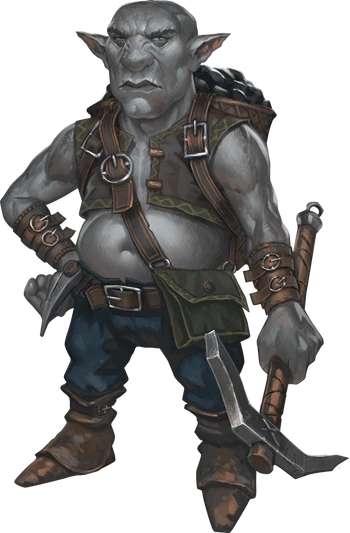
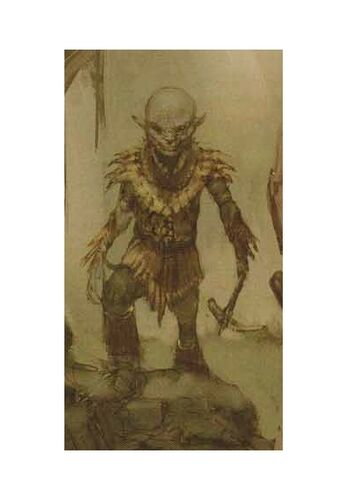
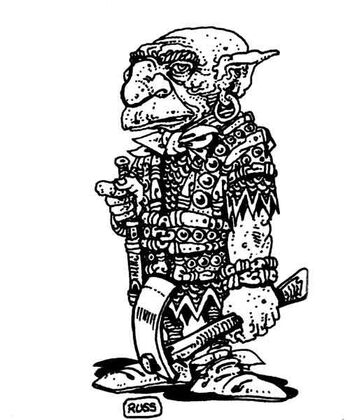
Deep Gnome/Svirfneblin
How do you even pronounce that word? "Svirfneblin" is a word I always mis-spell, and always mispronounce, going from snifflegoblin to snirfveldeblin to sniffvirfeblin... thank god "deep gnome" is there to make saying this race's name in a less tongue-twistery way, y'know? Basically, the sniffleboys live in the Underdark, and they appear to be the sort of 'evil counterpart' race living in the Underdark. Like how the Duergar are evil Underdark dwarves, the Drow are evil Underdark elves, the Troglodytes are evil Underdark Lizardmen... and the Deep Gnomes... are... just Underdark gnomes. That's the whole point of it. They are a subversion, because they aren't evil counterparts. They just live underground. And that's it. They're more dour and have kooky little gimmicks, like noting that the entire race doesn't have the concept of time-keeping and whatnot... but honestly, they're sort of kind of built around the fact of subverting expectations. They're pretty boring, and even with some extra material describing them as potential Player Character races in 5E, I really don't feel like they have anything particularly interesting to talk about.
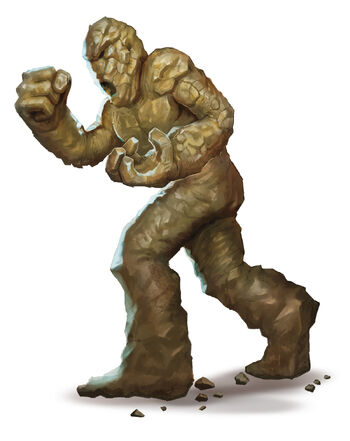
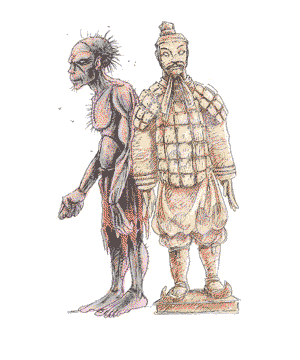
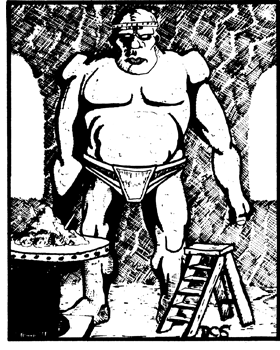
Clay Golem
Another one that tends to have multiple parts and multiple monsters in any edition's Monster Manual, fifth edition gives us four main golem types. And what makes a golem different is that they're created by a wizard. Even moreso than the other types of monsters, the golems have no feelings, no ambitions, feels nothing and knows nothing, just blindly following orders like a robot. They do contain a 'spirit' summoned from the elemental plane of earth, though, at least in the fifth edition, but that really doesn't make them particularly smart, and they aren't classified as 'true' earth elementals like the galeb duhr. The spark of life borrowed from the elemental plane has no personality, no emotions, no ambitions... basically, nothing at all beyond just allowing the golem to magically move. Yet another creature your adventurers can mercilessly cut down without remorse! Also, a lot of golems tend to have anti-magic properties due to the magic used in their creation.
The Clay Golem is just a huge creature made out of clay and mud, and apparently, are the most susceptible to basically 'malfunctioning' and cluelessly rampaging because clay isn't a good vessel for life force. I don't have much to say here, they certainly do make for a pretty cool, if gross-looking, enemy! The 2nd Edition artwork features an alternate depiction of a clay golem that looks like those Chinese Terracotta soldiers, which is actually pretty cool!
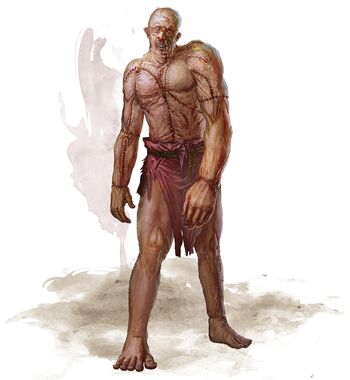
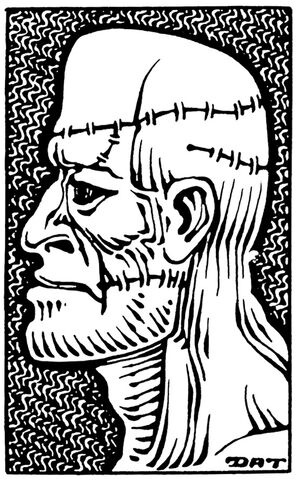
Flesh Golem
Obviously based on Frankenstein's Monster, the Flesh Golem is the weakest of the golem types and is, well, made out of the stitched-together parts of random corpses. It's not classified as an undead since it doesn't have any sort of necromantic energy or spooky undead spirit tied to it. Actually having a brain, though, the flesh golem can sometimes have some weird reasoning like a young child. And it's basically a huge homage to Frankenstein's monster, with lightning and electricity empowering the flesh golem and giving it a buff to its abilities. Again, like the clay golem, random human parts isn't the best container for an elemental spirit, and the flesh golem will also sometimes rampage if injured.
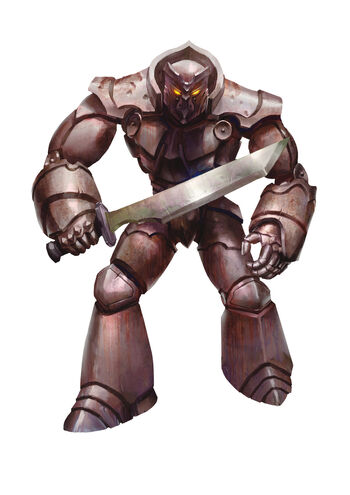
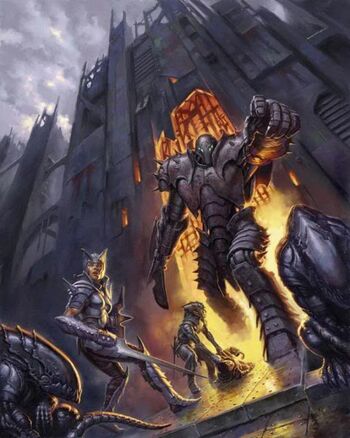
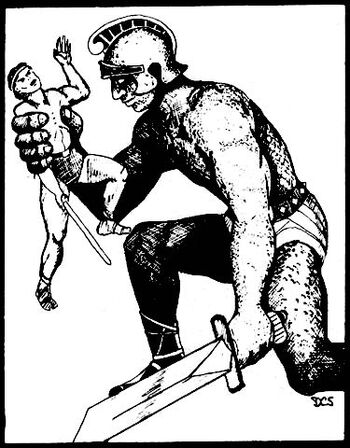
Iron Golem
And now we're getting to the coolest looking Iron Golem! Originally envisioned as what's basically a giant Greek-y iron statue that's animated, since 2E onwards, the Iron Golem has been consistently depicted as either a giant, hulking animated suit of armour, or what's basically a fantasy-land version of a giant robot... particularly that 3rd Edition artwork! They're the mightiest of the four basic golem types, and, again, a pretty damn cool looking metal robot-man. In addition to being immune to most magic and being a fuck-off giant robot, the iron golem is also smart enough to use basic weapons. And for some reason can breathe poison, which... yeah, sure, why not?
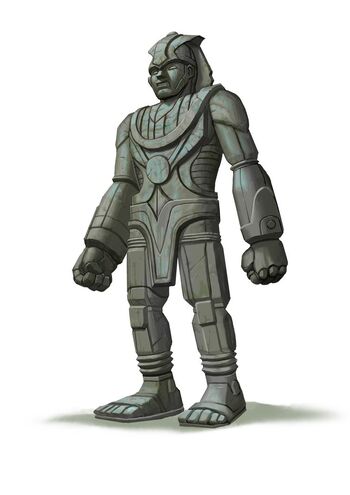
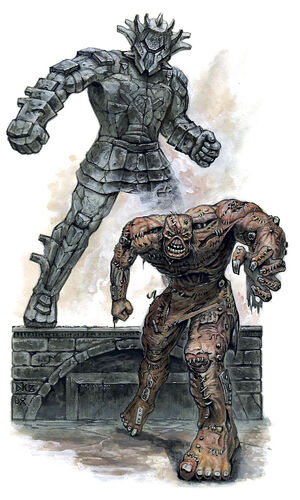
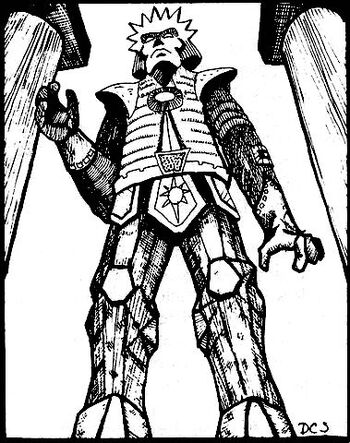
Stone Golem
The Stone Golems basically fill in the fantasy of "rock statue in a sacred tomb comes to life and tries to kill the heroes", and the Monster Manual notes the wide, wide variety in shape that stone golems come in. Perhaps the most thematic and archetypal of what one would think of as a golem guarding a tomb, the Stone Golems are noted to be able to appear in any shape or form, depending on what the sculptor of the golem wanted them to look like. The little combat gimmick that the 5E golem has is to cause creatures that fight it to feel like they're becoming stone themselves, slowing down and becoming sluggish. Golems are pretty cool! I really don't have a whole ton to say here, but unlike the deep gnomes and the goblins, I do have a strong fondness for these brainless automated magic statues.
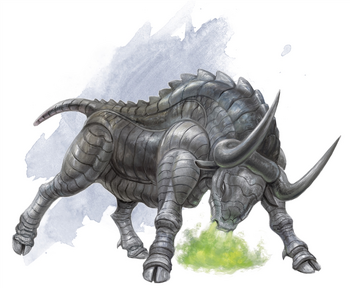
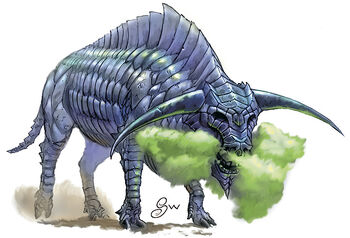

Gorgon
Okay, here's the Gorgon. Traditionally, based on the original Greek myths, the gorgon is a race of snake-haired women who can turn people into stone by staring at them. And these Grecian gorgons do appear in D&D... as the "Medusa" race, taking its name from the most famous member of the mythological gorgons. Instead, in D&D, the term "Gorgon" is this strange metallic rabid bull. Okay? The concept of the Gorgon's design is pretty neat, though, naming conventions aside. I do really love how they're consistently portrayed with hollow eyes in all their incarnations, whether it's the literal "bull with metal plates" of the earlier editions, or the far more robotic, metal-plated ones from 3E onwards. They breathe a toxic green mist that turns whatever it touches into stone, so at least the cow Gorgon has some sort of homage to the origins of its name. They're apparently carnivorous, too, with the Monster Manual detailing how it stalks prey and tramples potential prey to death, and its sharp robo-cow teeth is powerful enough to grind its petrified foes into nutritious dust. I do like the random little detail that the Gorgons have oil running through their body, and when they are sick, they "gather rust like fungus or mange". Okay. Not the most innovative monster, but one of those D&D-original ones that end up kind of becoming a 'classic', y'know? I don't mind this one.
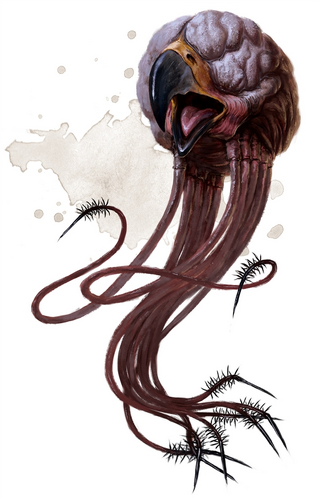
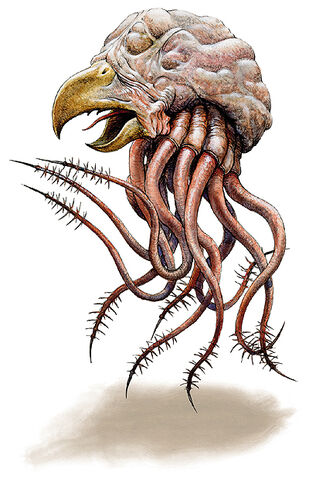
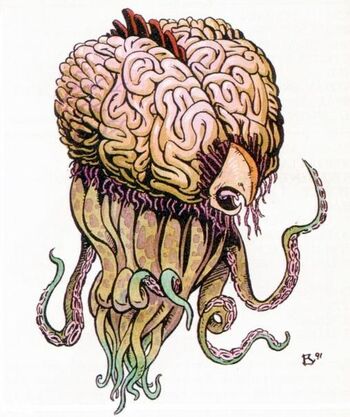
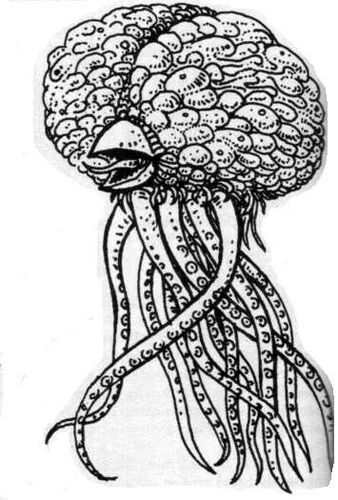
Grell
Eyyy, it's the fucking Grell! Another one of the D&D-original monsters, the Grell is one of the creatures from the original 1st edition Fiend Folio to somehow not be mocked and end up appearing as a 'core' monster in every single edition. It really is arbitrary, huh, just what creature end up taking people's fancy? The Flumph was a joke until recently, but with a straight face, they put in the floating floating brain jellyfish with a bird's beak in every single damn edition. And that's not to say that I hate the Grell, because I love this thing. Look at how utterly stupidly ridiculous it is! It's a gigantic brain, but with little octopus tendrils that trail down its base like a jellyfish, and it's got a big mean-looking bird beak on it. The Grell is another monster that's counted as an aberration, because in no way this thing is born out of natural evolution. I do really love just how at one point in the 1st Edition's development process, practically every second monster is a weird floating creature with tentacles or whatever. And I've seen Grells for so long that they've sort of became like a standard-looking D&D monster in my head the way beholders are, but I did remember the first time I saw a Grell in the 3.5E Monster Manual and went "what the fuuuuuuck". What a gloriously bizarre-ass creature.
And these things just sort of float around everywhere, using their tentacles which have retractable venomous barbs to manipulate objects, or to ambush random foolish adventurers who come near their lair. They're blind, but they can operate with hearing (with what ears?) and the ability to sense electrical fields... and is also immune to lightning because they use it to navigate. Okay? They're counted as 'neutral evil', and have their own language, so these brain jellyfish-birds are actually sentient, and they live in covens. I love these things. They look so weird, and I do really like the fact that the 5E Monster Manual notes that the Grell will try to manipulate adventurers to try and wage war against the other monstrous inhabitants of dungeons it calls home, while waiting for a chance to strike. Because, presumably, no adventurer will think that this dumb bird-brain-jellyfish thing is actually capable of sinister treachery.

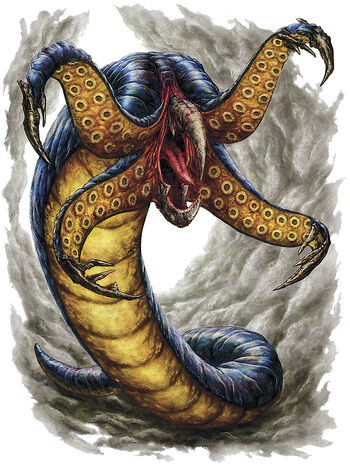
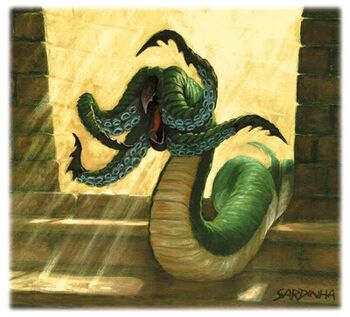
Grick
Right next to the Grell is the Grick, who is classified as a monstrosity, and I guess the difference between the two is what illustrates the difference of a 'monstrosity' and an 'aberration' the best. A monstrosity is a creature that is like a mixture of different animals (or plants), sometimes with a magical ability, sort of like chimeras and gryphons and manticores and cockatrices, which come from real-life myths... or critters like the Grick, which, despite being a giant worm with a bird beak and four massive octopus tentacles around its mouth, is still kind of a giant worm, y'know? It's not as bizarrely absurd and physics defying as the Grell, who is a floating brain with animal parts slapped onto it; you really wonder just how the hell the biology of the Grell even works. (Like this, because of course there's an anatomical cross-section of a brain jellyfish)
The Grick is sort of introduced in the 3rd Edition and has since shown up in every single core Monster Manual, and is characterized as an ambush predator that hail from the Underdark, basically hiding in rubble and debris and stalactites to ambush their prey, basically trying to hunt everything in an area that's not a fellow Grick. Their lairs are apparently infested with multiple members, and their lairs are apparently a hoard of cast-off possessions of past victims. When prey is scarce, though, they'll venture to the above-world, banding around in packs led by a larger, overfed Grick Alpha. I do like this thing, it's weird enough to feel like something genuinely unique, but at the same time, it's just kind of like a particularly monstrous animal. I like Gricks.
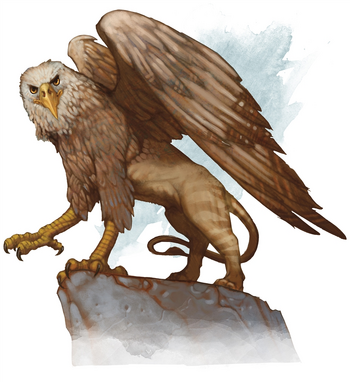
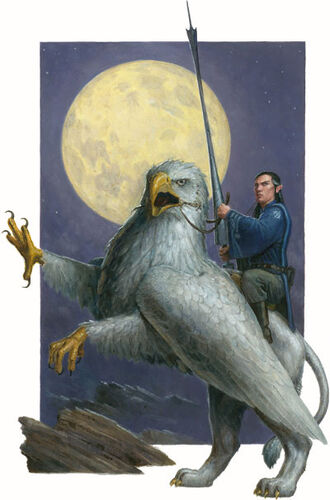
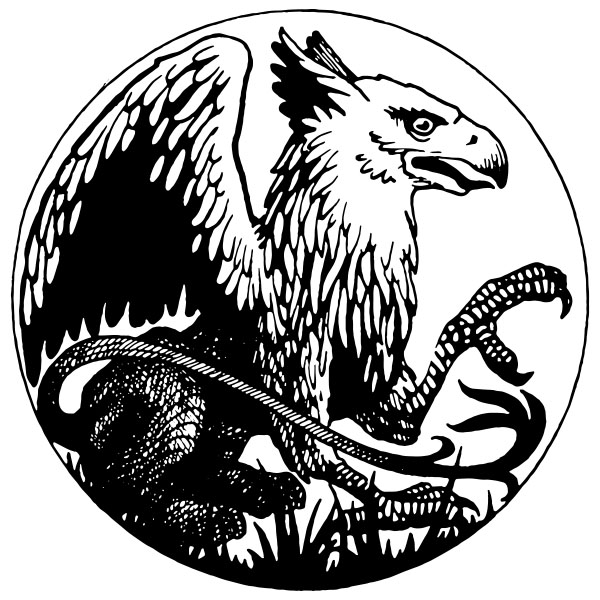
Griffon
One of the most common creatures in fantasy is the Griffon (or Gryphon -- I personally use the two interchangeably), another creature that hails from Greco-Roman mythology. A mixture of lions and eagles, noble, and just large enough to be a goddamn badass mount for elves to ride into combat as what's essentially an airborne cavalry, griffons are pretty dang cool! They're a common fixture and I think a whole lot of D&D settings and modules make the use of griffon riders to add just another dash of higher fantasy. Sure, a battalion of knights on horseback coming to the rescue of your adventuring party is cool and all, but you know what's more badass? A battalion of knights riding a bunch of winged, eagle-headed lions. Whether griffons are just intelligent beasts or straight-up sentient actually is sort of inconsistent between different editions, but even if they are, they tend to be all about the nobility and knightliness anyway, so it's all good. It's just not that easy to train a griffon, is all.
Griffons are also massive racists, by the way, something lifted straight from the mythology -- they hate horses. And they will murder horses, out of principle. And especially hippogriffs, how dare griffons and horses interbreed! Apparently, this makes them particularly useful to use against mounted riders. In addition to the whole air superiority thing. Wild griffons basically are territorial creatures that live on mountains and basically defend their hunting ground from rival griffons and the like. They're also surprisingly low as far as power-level goes in every D&D setting, probably so that it could be justified to have a bunch of flying knights on griffon-back without them being too overpowered.
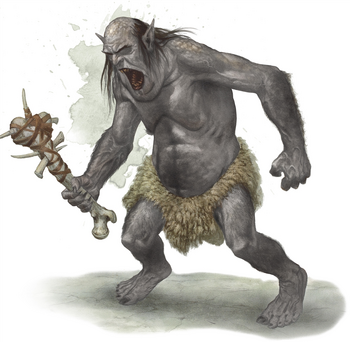
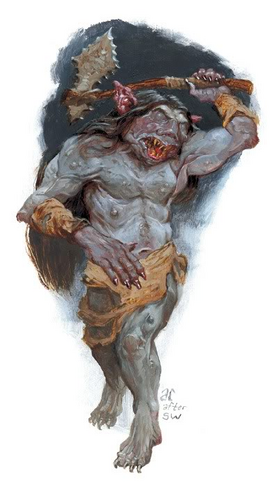
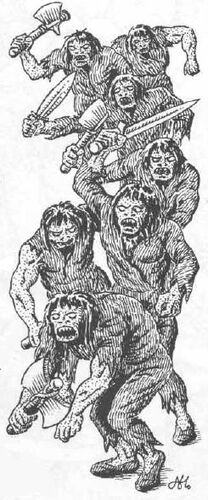
Grimlock
The Grimlocks, not to be confused with the dinosaur Transformer, actually draw their name from the Morlocks from H.G. Wells' The Time Machine, a race of brutish, blind, savage troglodyte-like descendants of mutated humans in the future that live underground. Since the D&D setting has the whole "Underdark" thing, it's no surprise that they introduced a race that's essentially a massive shout-out to the Morlocks. See, where the Underdark elves are psychotic sexy spider-worshiping cultists, the Underdark dwarves form dour warlike kingdoms and the Underdark gnomes are just boring, the Underdark humans are... well, savage, gray-skinned, eyeless cavemen. They were actually straight-up former humans that ended up being transformed by Mind Flayers into blind, monstrous cannibals. Apparently, these proto-Grimlocks worshiped the Mind Flayers as deities, and ended up adapting their practice of eating brains as some sort of holy sacrament in their rituals. Okay, then. That's like, funny and horrifying in the same breath. Over time the Grimlocks have sort of became their own society, basically becoming these blind hunters that patrol the Underdark and pounce upon anything that makes noises or smells like blood in their territories. They're like dumb, evil versions of Daredevil! Basically, they're like the brutish, dumb version of Skyrim's Falmer, another fantasy creature based on the Morlocks. Not the most interesting creature visually, but I do like the backstory.
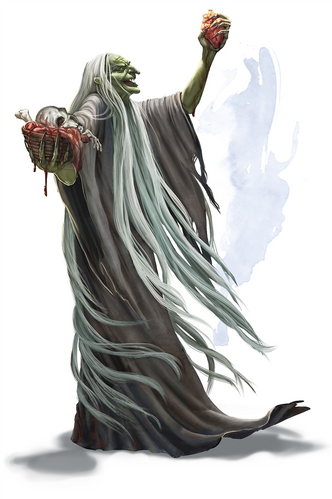
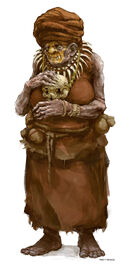
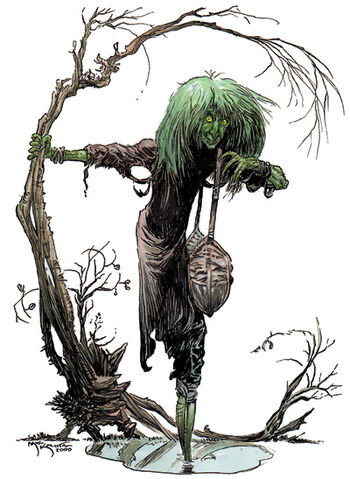
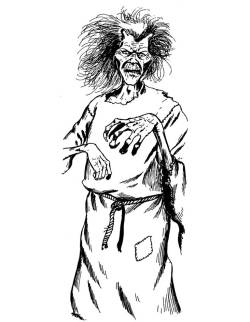
Hag: Green Hag
The first time I saw a 'hag' with multiple subtypes in the Monster Manual, I was confused... but then I realized just how much fairy tales and myths tended to focus on witches and evil crones living in the forest, kidnapping children and doing profane rituals. They appear in basically almost every edition of the D&D game, and sort of fluctuate on whether they're just particularly evil humanoids, or a sub-type of fey... although perhaps to avoid any unfortunate implications, most of the time they're just evil fey, not at all natural or mortal. Described as "cankers on the mortal world", their horrid crone-like appearance is a reflection of their wicked souls, and they actually thing conventional attractiveness is ugly and will actually attempt to disfigure others to 'fix' them. They're nasty magical witches, prefer illusion to trick their foes, and in a physical fight, they can literally rip your face off with their long claws. Also, more dangerous than a single hag? A whole coven of hags, where exactly three hags gather together and this tends to lead to attempts at backstabbing each other, but it gives them a shared pool of spells that they can cast together. Why three? Because the they will always get into a fight, and that way, they'll have a tiebreaker at every argument. In addition to that, the Monster Manual also describes a 'dark sorority' where all hags know all the other hags with a sort of a primitive, magical Facebook, and unlike dragons or fiends, hags tend to really respect each others' territories. Okay! Also, in a twisted homage to the Graeae of Greek myth, 5E gives covens the ability to create a Hag Eye, a magical token that a coven maintains together to spy on things. They're basically one of the perhaps slightly more frustrating enemies to fight, particularly in the middle levels. They also don't always appear to be evil, sometimes pretending to just be a normal, kooky old lady in the forest who offers deals, but, of course, it's the general sort of 'deal-with-the-devil' stuff.
Also, in a hideous adaptation of how hags and witches often go around abducting children, 5E details the way that hags reproduce... by snatching a human infant, devouring them, and this process somehow causes the hag to become pregnant and give birth to a hag that looks human until her thirteenth birthday before they transform into hags... which, because hags are massive assholes, sometimes they just allow the kid to be 'rescued' then laugh when the child transforms into a hag at her thirteenth birthday. Perhaps the most 'basic' hag in 5E is the Green Hag, sometimes called "Swamp Hag" or "Bog Hag". Their skin are green, presumably in homage to a certain famous wicked witch of the west, while her 5th edition artwork evokes the evil queen from Disney's Snow White. These dwell in forests, swamps and misty woods, delighting in manipulating and tricking victims with illusions and mimicked voices.
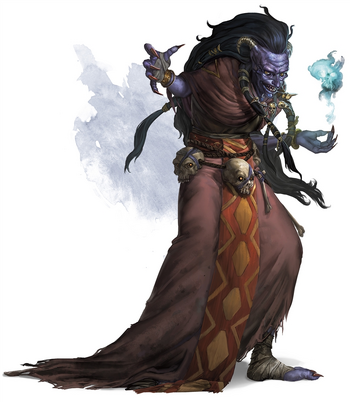
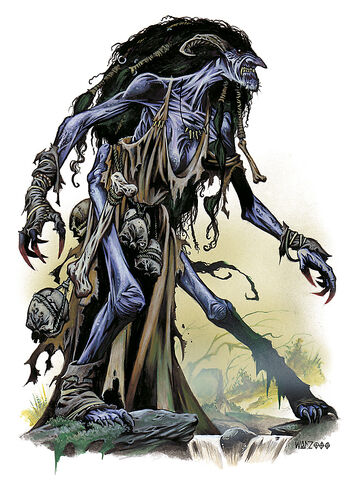
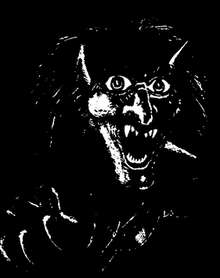
Hag: Night Hag
The night hag (known as just a "Hag" in the very first edition, and classified as a different type of monster than the other hags in 3E and 4E) is the most powerful of the hags included in 5E's Monster Manual, but there definitely are a whole lot of other additional hag sub-types in all of D&D's editions. Night hags tend to be portrayed as having purple-blue skin, and demonic horns. Most of the hags sort of share the same sort of themes going on, but night hags in particular love to corrupt good people and drive them into evilness. Like Emperor Palpatine! They're noted to specifically be banished to the lower planes, meaning that they're actually classified as fiends as opposed to fey. The night hags are able to ethereally attack a sleeping person and attack their dreams in additional attempts to corrupt their prey, something that actually work well with general myths about witches and other malicious forest spirits and the like. And after the death of the victim from many, many nightly visits, the night hag will be able to trap the victim's soul. It's like Freddy Krueger mixed with a succubus in a way.
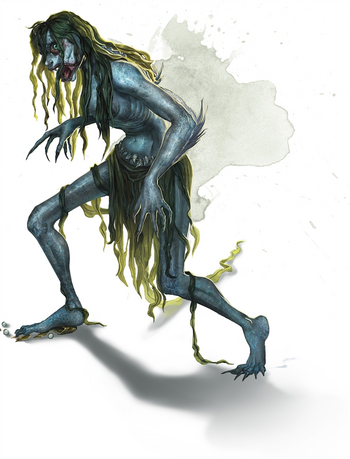
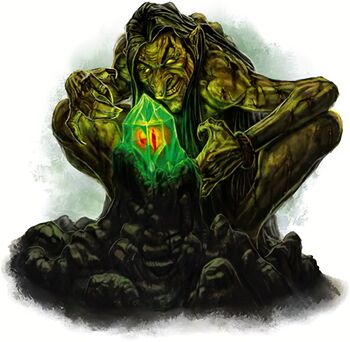
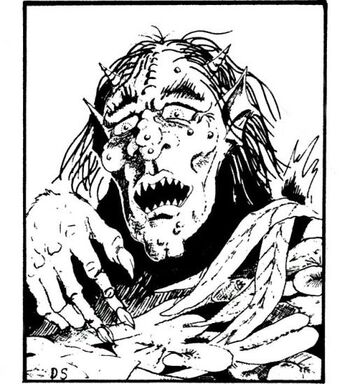
Hag: Sea Hag
And here's the Sea Hag, who lives in, well, the sea. I really do love the grisly artwork for the 5th Edition. By and by, most of the other hags have traded in their ripped-up clothing for robes that are more whole, but the sea hag still looks like a nasty, gangly half-drowned corpse with seaweed sticking all over her body. The sea hags are sort of like her other two cousins, except with a couple different sea-themed abilities. It's noted that the sea hags are the ones that specifically hate beauty in all forms, wanting to make everything look as hideous as her.
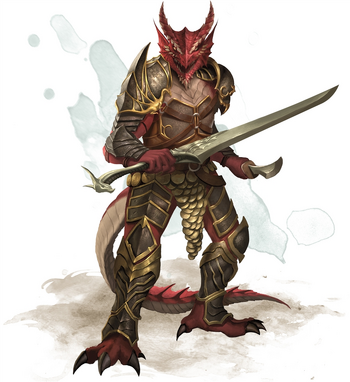
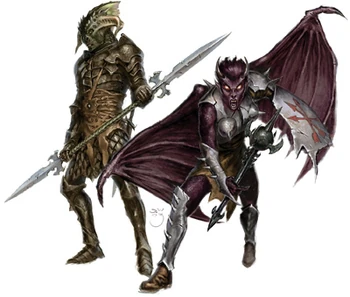
Half-Dragon
The half-dragon was a creature template that was introduced in 3rd Edition and sort of dropped in 4th edition with the introduction of the playable Dragonborn race. And now they're back! And... I'm legitimately not 100% sure about their lore, due to the rewrites and retcons about Dragonborns between 4E and 5E. Basically, though, the Dragonborns have basically settled into their own race and culture, being genetically stable enough to make more Dragonborn babies with each generation. Half-dragons are just... well, when a polymorphed dragon mates with another creature, the result ends up being these bastardized half-dragon creatures, which are noted to be straight-up sterile. Or sometimes crazy wizards doing experiments with dragon blood can transform you to these. Basically, the half-dragons are sort of like Dragonborns, getting some of that draconic resistance and a dragon breath attack. It's noted that any beast, humanoid, giant or monstrosity can become a half-dragon depending on just what type of non-dragon sex their parent prefers. So you can have, like, a half-dragon cyclops, a half-dragon bear, or even crazier stuff like a half-dragon Grick or a half-dragon Chimera (who's already part dragon?) if you want to. Okay! Honestly, I do kind of think that the humanoid variants of these are essentially sort of obsolete with the presence of the Dragonborns, but the idea of half-draconic animals and, more importantly, monstrosities running around the setting is pretty fun.
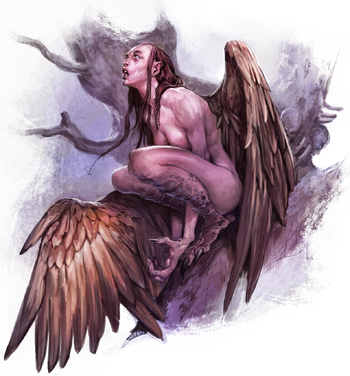
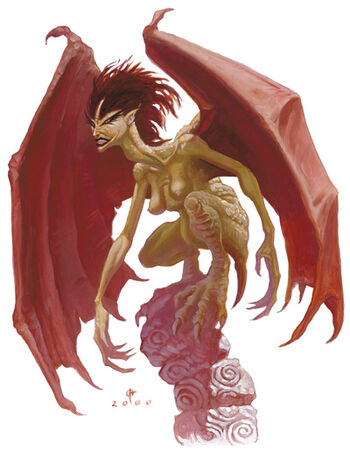
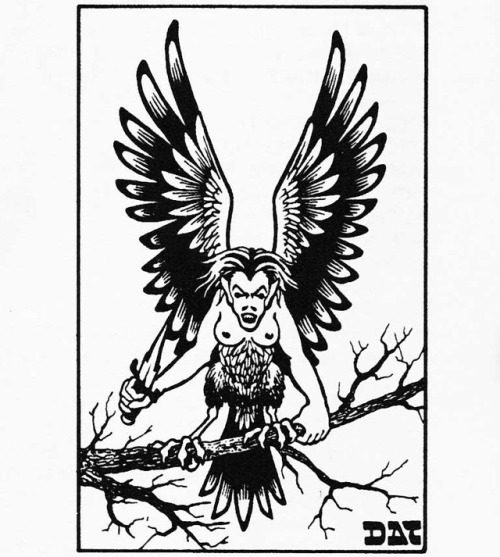
Harpy
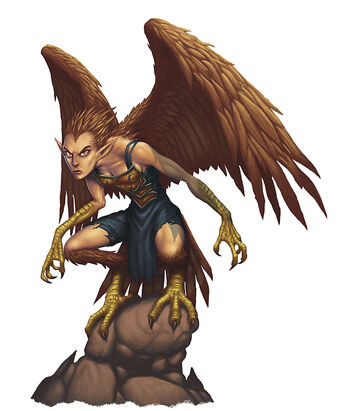 Here's another one from Greek mythology, the Harpy. Winged, screeching half-bird women that sometimes have power over the winds. While the classical representation of the harpy tended to not give them humanoid hands, just women with wings and talons instead of limbs, D&D's harpies are consistently shown to have wings. And while I do like the gangly, emancipated look of the 3rd Edition Harpy, I'm not a big fan of the random demon bat-wings they slapped onto her. 4th Edition Harpy resotres the bird wings, but gives her a far, far more heroic and civilized build that makes her look more like an anime protagonist instead of a screeching, nasty bird-woman out for blood, y'know? 5th Edition goes back to something more wretched looking, even if that expression is more mournful than sadistic. And... well, harpies are sort of a common video game enemy as well, yeah? I really don't have a whole ton to say here. Harpies are neat, crazy monstrous bird-women who will tear anything in her way to shreds. D&D harpies also have sort of a siren's song ability to charm its prey, which I'm 99% sure the mythological harpies didn't have. They are brutal beings who dismember their prey, and then keep the trinkets and baubles like a crazy raven or something. Not a whole lot more to say here... it's like the cyclops, y'know? It's a monster that's shown up in fiction so much that it's one of those creatures that are pretty familiar.
Here's another one from Greek mythology, the Harpy. Winged, screeching half-bird women that sometimes have power over the winds. While the classical representation of the harpy tended to not give them humanoid hands, just women with wings and talons instead of limbs, D&D's harpies are consistently shown to have wings. And while I do like the gangly, emancipated look of the 3rd Edition Harpy, I'm not a big fan of the random demon bat-wings they slapped onto her. 4th Edition Harpy resotres the bird wings, but gives her a far, far more heroic and civilized build that makes her look more like an anime protagonist instead of a screeching, nasty bird-woman out for blood, y'know? 5th Edition goes back to something more wretched looking, even if that expression is more mournful than sadistic. And... well, harpies are sort of a common video game enemy as well, yeah? I really don't have a whole ton to say here. Harpies are neat, crazy monstrous bird-women who will tear anything in her way to shreds. D&D harpies also have sort of a siren's song ability to charm its prey, which I'm 99% sure the mythological harpies didn't have. They are brutal beings who dismember their prey, and then keep the trinkets and baubles like a crazy raven or something. Not a whole lot more to say here... it's like the cyclops, y'know? It's a monster that's shown up in fiction so much that it's one of those creatures that are pretty familiar.
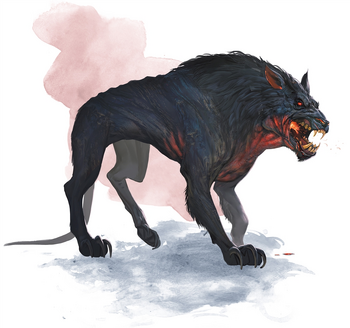
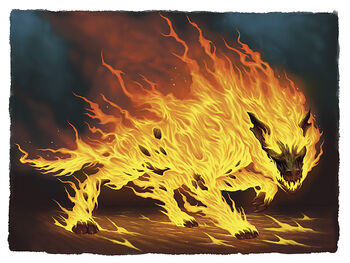
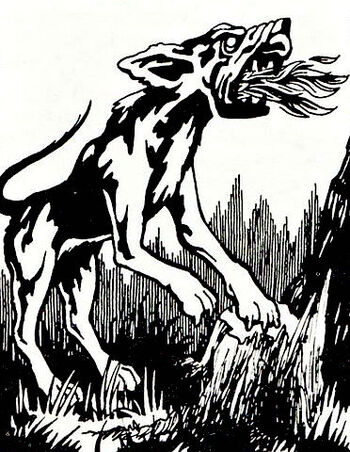
Hell Hound
And we have the Hell Hound, another creature that we commonly see in myths and legends. In the first through third editions, the Hell Hound is just a particularly nasty, rabid-looking dog that breathes fire, and then we get the 4th edition Hell Hound which is like, straight-up a dog made out of flames. Which is pretty fucking badass, I'm not going to lie. The 5th Edition goes back to what's perhaps more true to the original concept of just a 'hound out of hell', although 5E's Hell Hound looks far more mutated, with a grisly, more demonic face and an unnatural hump on its shoulders. I do like this change, making the hell hounds feel a bit more special compared to the blink dogs and worgs of the setting. It is very curious, though, because despite drawing a lot from mythologies, I don't think D&D ever adapted the most famous hell-hound of all, Cerberus. Or at least not in a core sourcebook, anyway. The Hell Hound is noted to be intelligent, but unable to really communicate with speech, and are definitely classified as fiends. They serve as intelligent guard dogs for devils, demons and sometimes fire giants. They're pack hunters, and they breathe fire, and when they die they blow up in flames. Not a whole ton else to talk about, honestly. They're pretty neat demon dogs!
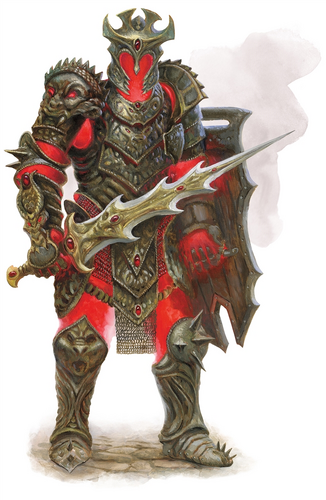
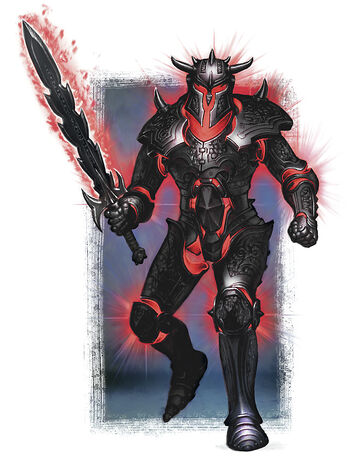
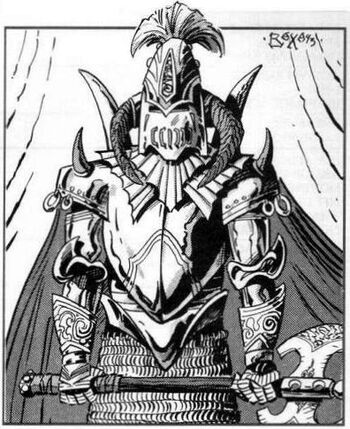
Helmed Horror
I could've sworn this is another new monster, but apparently the Helmed Horror has been around in every edition since 2E. I guess it just sort of blends into the other Iron Golems and Animated Armors and Warforged as far as being another set of reanimated armour? The 4th and 5th Edition's artwork is pretty neat, though, showing off what appears to be a suit of armour animated by a crimson humanoid figure, and I do really like that faceless visage. Basically, though, the Helmed Horror is like the 'elite' version of a regular Animated Armor, and can actually attempt to understand its owner's intent. Stronger, more resilient, and follows orders better. It's like Animated Armor 2.0, y'know? They upgraded the A.I. on this thing. Not a whole lot for me to say, honestly.
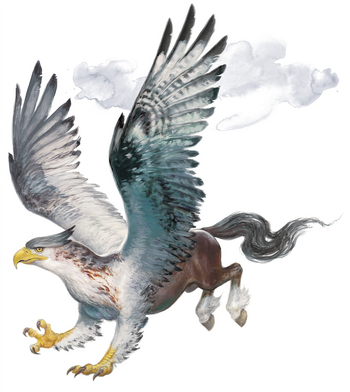
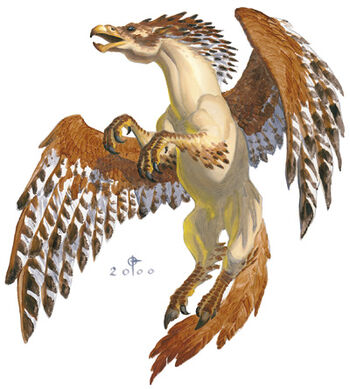
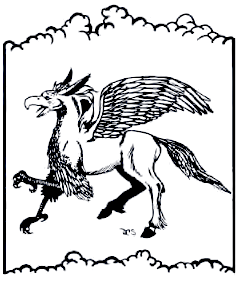
Hippogriff
And... hey, it's the griffin's cousin, the hippogriff! And something in some versions of the original legends about the hippogriff that's been sort of lost through time is that the hippogriff tended to be portrayed as a symbol of something that should not exist... or, alternatively, a symbol of true love. Because its parents, the horse and the griffon, are mortal enemies, they should not be able to breed. But in fantasy writing, the hippogriff is just sort of another flavour of a flying steed you can use. They're basically a bit lower than griffons on the totem pole, being a lot less savage and more concerned about protecting their young instead of hunting, because, well, they kind of lost the 'lion' part in the equation. They're basically a weaker version of a griffon, but far easier to train as a mount.
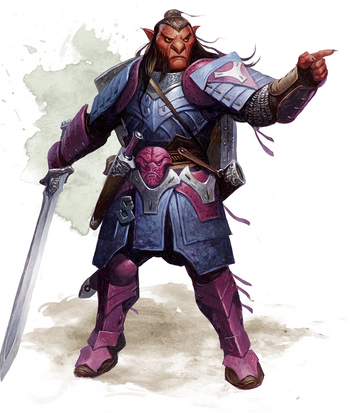
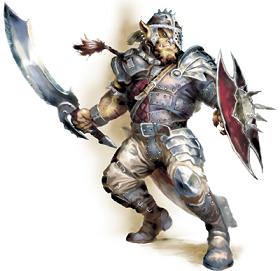
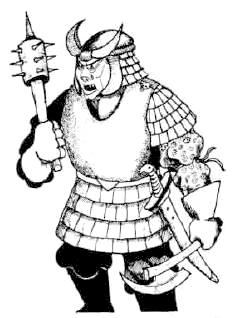
Hobgoblin
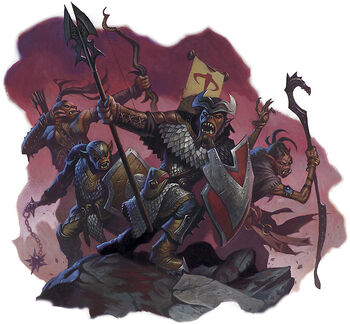 And here we go to the final goblinoid. After the sniveling, cruel goblins to the big, brutish bugbears, the hobgoblins are far, far more competent. Just look at that badass samurai-knight-man from 5th edition! I was so used into thinking that hobgoblins are just "goblins, but with non-midget proportions", that I was genuinely surprised to see that 5th Edition gave us a pretty badass looking hogoblin knight dude. They have dark orange or red skin, and they're basically the badass, martial versions of goblins. And hobgoblin armies are actually relatively disciplined and orderly, and they actually train with weapons and whatnot, and actually make use of scouting parties and planning, making up for their relatively average physical strength. They're also very much willing to organize other goblinoids or even other humanoid races to fill up their ranks, and even have their own crude cavalry made of beast-riders.
And here we go to the final goblinoid. After the sniveling, cruel goblins to the big, brutish bugbears, the hobgoblins are far, far more competent. Just look at that badass samurai-knight-man from 5th edition! I was so used into thinking that hobgoblins are just "goblins, but with non-midget proportions", that I was genuinely surprised to see that 5th Edition gave us a pretty badass looking hogoblin knight dude. They have dark orange or red skin, and they're basically the badass, martial versions of goblins. And hobgoblin armies are actually relatively disciplined and orderly, and they actually train with weapons and whatnot, and actually make use of scouting parties and planning, making up for their relatively average physical strength. They're also very much willing to organize other goblinoids or even other humanoid races to fill up their ranks, and even have their own crude cavalry made of beast-riders.
Of course, they're still goblinkind, so they're prone to violence and cruelty, and while disciplined among their own legion, different legions and tribes of hobgoblins can devolve into violence very quickly in 'negotiations'. The hobgoblins worship Maglubiyet, the unifying goblin god (he beat up all the previous goblin/hobgoblin/bugbear gods), and have a somewhat Valhalla-like religion of embracing death since it means they'll join Maglubiyet's legions in Acheron (regular goblins don't actually want to do so, since they'll still be the hobgoblins' bitches in Maglubiyet's legion). Volo's adds the fact that sometimes Maglubiyet will stir goblinkind to form massive war-bands and hosts, and it's the hobgoblins that are the head of these massive endeavours. It's neat, I guess, and the hobgoblin-led conquests are noted to not be the sort of burn-everything-enslave-everyone raids that gnolls would do, but rather simply conquering for the sake of territory -- so long as the original inhabitants actually kowtow to the hobgoblins, they will actually leave them alone. The only real problem that the goblinoid war hosts will have, of course, is with religion, since they will straight-up defile and tear down any temple that doesn't worship Maglubiyet or any of the other goblin gods.
Both goblins and hobgoblins are noted to be a potential 'monstrous PC race' in Volo's, and, well... based purely on their D&D lore, I can buy hobgoblins having the actual intelligence and reasoning to actually turn back on their people's more brutal ways and attempt to hang out as an adventurer. Or to be the token 'restrained evil' teammate. Honestly, though, with the way the hobgoblins are shown here, it's really not outside the realm of possibility that an entire hobgoblin nation ends up getting set up and they enter into a more-or-less cordial relationship with other nations.
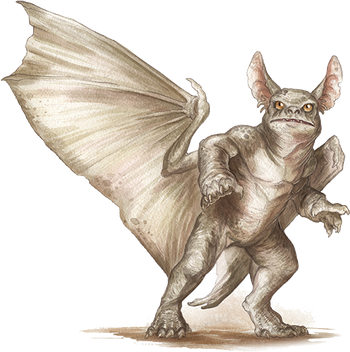
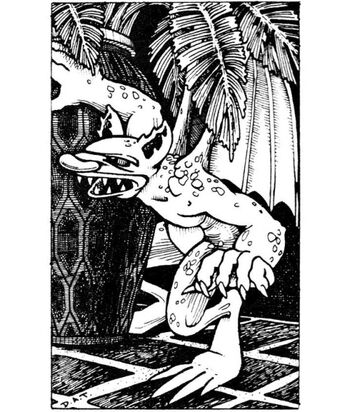
Homunculus
Throughout the five main editions, the basic homunculus has always been portrayed as a little winged imp-like figure, and I actually really like just how different the 3rd edition one is, which just looks so wretched with that rocky toad-like face, those disturbingly human hands and its wings being tattered and hanging limply. The homunculus is essentially a "tiny person" in 16th-century alchemy, and in D&D, wizards can do a ritual with a mixture of ingredients to create this tiny little critter. The homunculus essentially shares thoughts, senses and language with its creator, acting like an extension of its creator's will. It's kind of an interesting alternative to a magician's familiar, although ultimately I think in actual gameplay it's not very practical. I've always found them to be kind of boring, like a less-sinister version of an imp or quasit... hell, I don't think they honestly have any sort of personality, just latching on to its creator and being a familiar. I've always felt like they're kinda just there, just as an option if you wanted to a character to have a familiar.
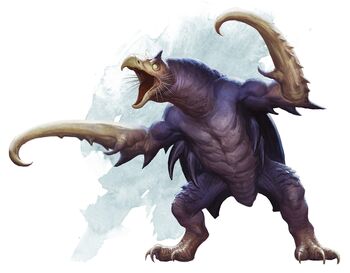
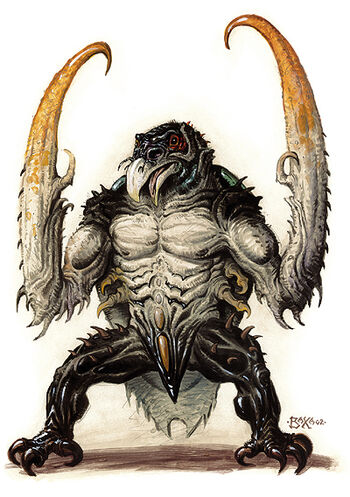
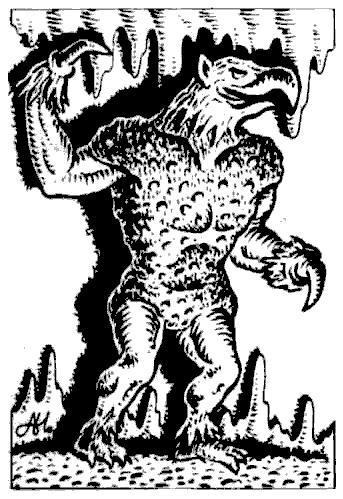
Hook Horror
The Hook Horror is another one of my favourites as far as weird Underdark monstrosities go. Originally introduced in the 1st Edition's Fiend Folio, where some of the weirdest monsters in D&D hail from, the Hook Horror was initially just a huge muscle-bound rock dude with a weird bird's head and hooks for hands. Which evolved into the far, far cooler-looking creature in the 2nd Edition artwork, which made the Hook Horror a mixture of insect and bird parts. Look at that beetle-like carapace, those gangly insect-leg arms, the thin bird-head and the general weirdness of this creature! And then from 3E onwards we've basically had what became the enduring look of the Hook Horrors, with the little insect hooks becoming gigantic bony hook-arms, and the Hook Horror's main body given some muscles because it apparently worked out. I'm not the biggest fan of 3rd Edition's weird pose or the contorted bird-head, but subsequent editions -- 4E and 5E -- gives it a far more natural and bestial look. It's a massive turtle-bug-bird with giant bony claws for hands, and I really do like just how much more natural-looking the anatomy of the 5th Edition artwork looks... as natural-looking as the Hook Horror can look, anyway.
You are now reading the article Reviewing D&D Monsters - 5E Monster Manual, Goblins to Kenku with link address https://kanakoroku.blogspot.com/2019/11/reviewing-d-monsters-5e-monster-manual_4.html
Title : Reviewing D&D Monsters - 5E Monster Manual, Goblins to Kenku
link : Reviewing D&D Monsters - 5E Monster Manual, Goblins to Kenku
Reviewing D&D Monsters - 5E Monster Manual, Goblins to Kenku
More D&D monsters! Yeah, I know, Svirfneblins technically come between gnolls and goblins, but it's so clunky to write "Gnome, Deep to Kenku", and I do like to have the titles be catchy and the goblins are like one of the most notable monsters out there.Click here for the previous part, covering Fomorians to Gnolls.
Click here for the next part, covering Kobolds to Mimics.
Click here for the index.


Goblin
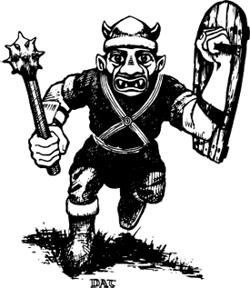 |
| 1E Goblin |
 |
| Pathfinder Goblins |



Deep Gnome/Svirfneblin
How do you even pronounce that word? "Svirfneblin" is a word I always mis-spell, and always mispronounce, going from snifflegoblin to snirfveldeblin to sniffvirfeblin... thank god "deep gnome" is there to make saying this race's name in a less tongue-twistery way, y'know? Basically, the sniffleboys live in the Underdark, and they appear to be the sort of 'evil counterpart' race living in the Underdark. Like how the Duergar are evil Underdark dwarves, the Drow are evil Underdark elves, the Troglodytes are evil Underdark Lizardmen... and the Deep Gnomes... are... just Underdark gnomes. That's the whole point of it. They are a subversion, because they aren't evil counterparts. They just live underground. And that's it. They're more dour and have kooky little gimmicks, like noting that the entire race doesn't have the concept of time-keeping and whatnot... but honestly, they're sort of kind of built around the fact of subverting expectations. They're pretty boring, and even with some extra material describing them as potential Player Character races in 5E, I really don't feel like they have anything particularly interesting to talk about.



Clay Golem
Another one that tends to have multiple parts and multiple monsters in any edition's Monster Manual, fifth edition gives us four main golem types. And what makes a golem different is that they're created by a wizard. Even moreso than the other types of monsters, the golems have no feelings, no ambitions, feels nothing and knows nothing, just blindly following orders like a robot. They do contain a 'spirit' summoned from the elemental plane of earth, though, at least in the fifth edition, but that really doesn't make them particularly smart, and they aren't classified as 'true' earth elementals like the galeb duhr. The spark of life borrowed from the elemental plane has no personality, no emotions, no ambitions... basically, nothing at all beyond just allowing the golem to magically move. Yet another creature your adventurers can mercilessly cut down without remorse! Also, a lot of golems tend to have anti-magic properties due to the magic used in their creation.
The Clay Golem is just a huge creature made out of clay and mud, and apparently, are the most susceptible to basically 'malfunctioning' and cluelessly rampaging because clay isn't a good vessel for life force. I don't have much to say here, they certainly do make for a pretty cool, if gross-looking, enemy! The 2nd Edition artwork features an alternate depiction of a clay golem that looks like those Chinese Terracotta soldiers, which is actually pretty cool!


Flesh Golem
Obviously based on Frankenstein's Monster, the Flesh Golem is the weakest of the golem types and is, well, made out of the stitched-together parts of random corpses. It's not classified as an undead since it doesn't have any sort of necromantic energy or spooky undead spirit tied to it. Actually having a brain, though, the flesh golem can sometimes have some weird reasoning like a young child. And it's basically a huge homage to Frankenstein's monster, with lightning and electricity empowering the flesh golem and giving it a buff to its abilities. Again, like the clay golem, random human parts isn't the best container for an elemental spirit, and the flesh golem will also sometimes rampage if injured.



Iron Golem
And now we're getting to the coolest looking Iron Golem! Originally envisioned as what's basically a giant Greek-y iron statue that's animated, since 2E onwards, the Iron Golem has been consistently depicted as either a giant, hulking animated suit of armour, or what's basically a fantasy-land version of a giant robot... particularly that 3rd Edition artwork! They're the mightiest of the four basic golem types, and, again, a pretty damn cool looking metal robot-man. In addition to being immune to most magic and being a fuck-off giant robot, the iron golem is also smart enough to use basic weapons. And for some reason can breathe poison, which... yeah, sure, why not?



Stone Golem
The Stone Golems basically fill in the fantasy of "rock statue in a sacred tomb comes to life and tries to kill the heroes", and the Monster Manual notes the wide, wide variety in shape that stone golems come in. Perhaps the most thematic and archetypal of what one would think of as a golem guarding a tomb, the Stone Golems are noted to be able to appear in any shape or form, depending on what the sculptor of the golem wanted them to look like. The little combat gimmick that the 5E golem has is to cause creatures that fight it to feel like they're becoming stone themselves, slowing down and becoming sluggish. Golems are pretty cool! I really don't have a whole ton to say here, but unlike the deep gnomes and the goblins, I do have a strong fondness for these brainless automated magic statues.



Gorgon
Okay, here's the Gorgon. Traditionally, based on the original Greek myths, the gorgon is a race of snake-haired women who can turn people into stone by staring at them. And these Grecian gorgons do appear in D&D... as the "Medusa" race, taking its name from the most famous member of the mythological gorgons. Instead, in D&D, the term "Gorgon" is this strange metallic rabid bull. Okay? The concept of the Gorgon's design is pretty neat, though, naming conventions aside. I do really love how they're consistently portrayed with hollow eyes in all their incarnations, whether it's the literal "bull with metal plates" of the earlier editions, or the far more robotic, metal-plated ones from 3E onwards. They breathe a toxic green mist that turns whatever it touches into stone, so at least the cow Gorgon has some sort of homage to the origins of its name. They're apparently carnivorous, too, with the Monster Manual detailing how it stalks prey and tramples potential prey to death, and its sharp robo-cow teeth is powerful enough to grind its petrified foes into nutritious dust. I do like the random little detail that the Gorgons have oil running through their body, and when they are sick, they "gather rust like fungus or mange". Okay. Not the most innovative monster, but one of those D&D-original ones that end up kind of becoming a 'classic', y'know? I don't mind this one.




Grell
Eyyy, it's the fucking Grell! Another one of the D&D-original monsters, the Grell is one of the creatures from the original 1st edition Fiend Folio to somehow not be mocked and end up appearing as a 'core' monster in every single edition. It really is arbitrary, huh, just what creature end up taking people's fancy? The Flumph was a joke until recently, but with a straight face, they put in the floating floating brain jellyfish with a bird's beak in every single damn edition. And that's not to say that I hate the Grell, because I love this thing. Look at how utterly stupidly ridiculous it is! It's a gigantic brain, but with little octopus tendrils that trail down its base like a jellyfish, and it's got a big mean-looking bird beak on it. The Grell is another monster that's counted as an aberration, because in no way this thing is born out of natural evolution. I do really love just how at one point in the 1st Edition's development process, practically every second monster is a weird floating creature with tentacles or whatever. And I've seen Grells for so long that they've sort of became like a standard-looking D&D monster in my head the way beholders are, but I did remember the first time I saw a Grell in the 3.5E Monster Manual and went "what the fuuuuuuck". What a gloriously bizarre-ass creature.
And these things just sort of float around everywhere, using their tentacles which have retractable venomous barbs to manipulate objects, or to ambush random foolish adventurers who come near their lair. They're blind, but they can operate with hearing (with what ears?) and the ability to sense electrical fields... and is also immune to lightning because they use it to navigate. Okay? They're counted as 'neutral evil', and have their own language, so these brain jellyfish-birds are actually sentient, and they live in covens. I love these things. They look so weird, and I do really like the fact that the 5E Monster Manual notes that the Grell will try to manipulate adventurers to try and wage war against the other monstrous inhabitants of dungeons it calls home, while waiting for a chance to strike. Because, presumably, no adventurer will think that this dumb bird-brain-jellyfish thing is actually capable of sinister treachery.



Grick
Right next to the Grell is the Grick, who is classified as a monstrosity, and I guess the difference between the two is what illustrates the difference of a 'monstrosity' and an 'aberration' the best. A monstrosity is a creature that is like a mixture of different animals (or plants), sometimes with a magical ability, sort of like chimeras and gryphons and manticores and cockatrices, which come from real-life myths... or critters like the Grick, which, despite being a giant worm with a bird beak and four massive octopus tentacles around its mouth, is still kind of a giant worm, y'know? It's not as bizarrely absurd and physics defying as the Grell, who is a floating brain with animal parts slapped onto it; you really wonder just how the hell the biology of the Grell even works. (Like this, because of course there's an anatomical cross-section of a brain jellyfish)
The Grick is sort of introduced in the 3rd Edition and has since shown up in every single core Monster Manual, and is characterized as an ambush predator that hail from the Underdark, basically hiding in rubble and debris and stalactites to ambush their prey, basically trying to hunt everything in an area that's not a fellow Grick. Their lairs are apparently infested with multiple members, and their lairs are apparently a hoard of cast-off possessions of past victims. When prey is scarce, though, they'll venture to the above-world, banding around in packs led by a larger, overfed Grick Alpha. I do like this thing, it's weird enough to feel like something genuinely unique, but at the same time, it's just kind of like a particularly monstrous animal. I like Gricks.



Griffon
One of the most common creatures in fantasy is the Griffon (or Gryphon -- I personally use the two interchangeably), another creature that hails from Greco-Roman mythology. A mixture of lions and eagles, noble, and just large enough to be a goddamn badass mount for elves to ride into combat as what's essentially an airborne cavalry, griffons are pretty dang cool! They're a common fixture and I think a whole lot of D&D settings and modules make the use of griffon riders to add just another dash of higher fantasy. Sure, a battalion of knights on horseback coming to the rescue of your adventuring party is cool and all, but you know what's more badass? A battalion of knights riding a bunch of winged, eagle-headed lions. Whether griffons are just intelligent beasts or straight-up sentient actually is sort of inconsistent between different editions, but even if they are, they tend to be all about the nobility and knightliness anyway, so it's all good. It's just not that easy to train a griffon, is all.
Griffons are also massive racists, by the way, something lifted straight from the mythology -- they hate horses. And they will murder horses, out of principle. And especially hippogriffs, how dare griffons and horses interbreed! Apparently, this makes them particularly useful to use against mounted riders. In addition to the whole air superiority thing. Wild griffons basically are territorial creatures that live on mountains and basically defend their hunting ground from rival griffons and the like. They're also surprisingly low as far as power-level goes in every D&D setting, probably so that it could be justified to have a bunch of flying knights on griffon-back without them being too overpowered.



Grimlock
The Grimlocks, not to be confused with the dinosaur Transformer, actually draw their name from the Morlocks from H.G. Wells' The Time Machine, a race of brutish, blind, savage troglodyte-like descendants of mutated humans in the future that live underground. Since the D&D setting has the whole "Underdark" thing, it's no surprise that they introduced a race that's essentially a massive shout-out to the Morlocks. See, where the Underdark elves are psychotic sexy spider-worshiping cultists, the Underdark dwarves form dour warlike kingdoms and the Underdark gnomes are just boring, the Underdark humans are... well, savage, gray-skinned, eyeless cavemen. They were actually straight-up former humans that ended up being transformed by Mind Flayers into blind, monstrous cannibals. Apparently, these proto-Grimlocks worshiped the Mind Flayers as deities, and ended up adapting their practice of eating brains as some sort of holy sacrament in their rituals. Okay, then. That's like, funny and horrifying in the same breath. Over time the Grimlocks have sort of became their own society, basically becoming these blind hunters that patrol the Underdark and pounce upon anything that makes noises or smells like blood in their territories. They're like dumb, evil versions of Daredevil! Basically, they're like the brutish, dumb version of Skyrim's Falmer, another fantasy creature based on the Morlocks. Not the most interesting creature visually, but I do like the backstory.




Hag: Green Hag
The first time I saw a 'hag' with multiple subtypes in the Monster Manual, I was confused... but then I realized just how much fairy tales and myths tended to focus on witches and evil crones living in the forest, kidnapping children and doing profane rituals. They appear in basically almost every edition of the D&D game, and sort of fluctuate on whether they're just particularly evil humanoids, or a sub-type of fey... although perhaps to avoid any unfortunate implications, most of the time they're just evil fey, not at all natural or mortal. Described as "cankers on the mortal world", their horrid crone-like appearance is a reflection of their wicked souls, and they actually thing conventional attractiveness is ugly and will actually attempt to disfigure others to 'fix' them. They're nasty magical witches, prefer illusion to trick their foes, and in a physical fight, they can literally rip your face off with their long claws. Also, more dangerous than a single hag? A whole coven of hags, where exactly three hags gather together and this tends to lead to attempts at backstabbing each other, but it gives them a shared pool of spells that they can cast together. Why three? Because the they will always get into a fight, and that way, they'll have a tiebreaker at every argument. In addition to that, the Monster Manual also describes a 'dark sorority' where all hags know all the other hags with a sort of a primitive, magical Facebook, and unlike dragons or fiends, hags tend to really respect each others' territories. Okay! Also, in a twisted homage to the Graeae of Greek myth, 5E gives covens the ability to create a Hag Eye, a magical token that a coven maintains together to spy on things. They're basically one of the perhaps slightly more frustrating enemies to fight, particularly in the middle levels. They also don't always appear to be evil, sometimes pretending to just be a normal, kooky old lady in the forest who offers deals, but, of course, it's the general sort of 'deal-with-the-devil' stuff.
Also, in a hideous adaptation of how hags and witches often go around abducting children, 5E details the way that hags reproduce... by snatching a human infant, devouring them, and this process somehow causes the hag to become pregnant and give birth to a hag that looks human until her thirteenth birthday before they transform into hags... which, because hags are massive assholes, sometimes they just allow the kid to be 'rescued' then laugh when the child transforms into a hag at her thirteenth birthday. Perhaps the most 'basic' hag in 5E is the Green Hag, sometimes called "Swamp Hag" or "Bog Hag". Their skin are green, presumably in homage to a certain famous wicked witch of the west, while her 5th edition artwork evokes the evil queen from Disney's Snow White. These dwell in forests, swamps and misty woods, delighting in manipulating and tricking victims with illusions and mimicked voices.



Hag: Night Hag
The night hag (known as just a "Hag" in the very first edition, and classified as a different type of monster than the other hags in 3E and 4E) is the most powerful of the hags included in 5E's Monster Manual, but there definitely are a whole lot of other additional hag sub-types in all of D&D's editions. Night hags tend to be portrayed as having purple-blue skin, and demonic horns. Most of the hags sort of share the same sort of themes going on, but night hags in particular love to corrupt good people and drive them into evilness. Like Emperor Palpatine! They're noted to specifically be banished to the lower planes, meaning that they're actually classified as fiends as opposed to fey. The night hags are able to ethereally attack a sleeping person and attack their dreams in additional attempts to corrupt their prey, something that actually work well with general myths about witches and other malicious forest spirits and the like. And after the death of the victim from many, many nightly visits, the night hag will be able to trap the victim's soul. It's like Freddy Krueger mixed with a succubus in a way.



Hag: Sea Hag
And here's the Sea Hag, who lives in, well, the sea. I really do love the grisly artwork for the 5th Edition. By and by, most of the other hags have traded in their ripped-up clothing for robes that are more whole, but the sea hag still looks like a nasty, gangly half-drowned corpse with seaweed sticking all over her body. The sea hags are sort of like her other two cousins, except with a couple different sea-themed abilities. It's noted that the sea hags are the ones that specifically hate beauty in all forms, wanting to make everything look as hideous as her.


Half-Dragon
The half-dragon was a creature template that was introduced in 3rd Edition and sort of dropped in 4th edition with the introduction of the playable Dragonborn race. And now they're back! And... I'm legitimately not 100% sure about their lore, due to the rewrites and retcons about Dragonborns between 4E and 5E. Basically, though, the Dragonborns have basically settled into their own race and culture, being genetically stable enough to make more Dragonborn babies with each generation. Half-dragons are just... well, when a polymorphed dragon mates with another creature, the result ends up being these bastardized half-dragon creatures, which are noted to be straight-up sterile. Or sometimes crazy wizards doing experiments with dragon blood can transform you to these. Basically, the half-dragons are sort of like Dragonborns, getting some of that draconic resistance and a dragon breath attack. It's noted that any beast, humanoid, giant or monstrosity can become a half-dragon depending on just what type of non-dragon sex their parent prefers. So you can have, like, a half-dragon cyclops, a half-dragon bear, or even crazier stuff like a half-dragon Grick or a half-dragon Chimera (who's already part dragon?) if you want to. Okay! Honestly, I do kind of think that the humanoid variants of these are essentially sort of obsolete with the presence of the Dragonborns, but the idea of half-draconic animals and, more importantly, monstrosities running around the setting is pretty fun.



Harpy
 Here's another one from Greek mythology, the Harpy. Winged, screeching half-bird women that sometimes have power over the winds. While the classical representation of the harpy tended to not give them humanoid hands, just women with wings and talons instead of limbs, D&D's harpies are consistently shown to have wings. And while I do like the gangly, emancipated look of the 3rd Edition Harpy, I'm not a big fan of the random demon bat-wings they slapped onto her. 4th Edition Harpy resotres the bird wings, but gives her a far, far more heroic and civilized build that makes her look more like an anime protagonist instead of a screeching, nasty bird-woman out for blood, y'know? 5th Edition goes back to something more wretched looking, even if that expression is more mournful than sadistic. And... well, harpies are sort of a common video game enemy as well, yeah? I really don't have a whole ton to say here. Harpies are neat, crazy monstrous bird-women who will tear anything in her way to shreds. D&D harpies also have sort of a siren's song ability to charm its prey, which I'm 99% sure the mythological harpies didn't have. They are brutal beings who dismember their prey, and then keep the trinkets and baubles like a crazy raven or something. Not a whole lot more to say here... it's like the cyclops, y'know? It's a monster that's shown up in fiction so much that it's one of those creatures that are pretty familiar.
Here's another one from Greek mythology, the Harpy. Winged, screeching half-bird women that sometimes have power over the winds. While the classical representation of the harpy tended to not give them humanoid hands, just women with wings and talons instead of limbs, D&D's harpies are consistently shown to have wings. And while I do like the gangly, emancipated look of the 3rd Edition Harpy, I'm not a big fan of the random demon bat-wings they slapped onto her. 4th Edition Harpy resotres the bird wings, but gives her a far, far more heroic and civilized build that makes her look more like an anime protagonist instead of a screeching, nasty bird-woman out for blood, y'know? 5th Edition goes back to something more wretched looking, even if that expression is more mournful than sadistic. And... well, harpies are sort of a common video game enemy as well, yeah? I really don't have a whole ton to say here. Harpies are neat, crazy monstrous bird-women who will tear anything in her way to shreds. D&D harpies also have sort of a siren's song ability to charm its prey, which I'm 99% sure the mythological harpies didn't have. They are brutal beings who dismember their prey, and then keep the trinkets and baubles like a crazy raven or something. Not a whole lot more to say here... it's like the cyclops, y'know? It's a monster that's shown up in fiction so much that it's one of those creatures that are pretty familiar.


Hell Hound
And we have the Hell Hound, another creature that we commonly see in myths and legends. In the first through third editions, the Hell Hound is just a particularly nasty, rabid-looking dog that breathes fire, and then we get the 4th edition Hell Hound which is like, straight-up a dog made out of flames. Which is pretty fucking badass, I'm not going to lie. The 5th Edition goes back to what's perhaps more true to the original concept of just a 'hound out of hell', although 5E's Hell Hound looks far more mutated, with a grisly, more demonic face and an unnatural hump on its shoulders. I do like this change, making the hell hounds feel a bit more special compared to the blink dogs and worgs of the setting. It is very curious, though, because despite drawing a lot from mythologies, I don't think D&D ever adapted the most famous hell-hound of all, Cerberus. Or at least not in a core sourcebook, anyway. The Hell Hound is noted to be intelligent, but unable to really communicate with speech, and are definitely classified as fiends. They serve as intelligent guard dogs for devils, demons and sometimes fire giants. They're pack hunters, and they breathe fire, and when they die they blow up in flames. Not a whole ton else to talk about, honestly. They're pretty neat demon dogs!



Helmed Horror
I could've sworn this is another new monster, but apparently the Helmed Horror has been around in every edition since 2E. I guess it just sort of blends into the other Iron Golems and Animated Armors and Warforged as far as being another set of reanimated armour? The 4th and 5th Edition's artwork is pretty neat, though, showing off what appears to be a suit of armour animated by a crimson humanoid figure, and I do really like that faceless visage. Basically, though, the Helmed Horror is like the 'elite' version of a regular Animated Armor, and can actually attempt to understand its owner's intent. Stronger, more resilient, and follows orders better. It's like Animated Armor 2.0, y'know? They upgraded the A.I. on this thing. Not a whole lot for me to say, honestly.



Hippogriff
And... hey, it's the griffin's cousin, the hippogriff! And something in some versions of the original legends about the hippogriff that's been sort of lost through time is that the hippogriff tended to be portrayed as a symbol of something that should not exist... or, alternatively, a symbol of true love. Because its parents, the horse and the griffon, are mortal enemies, they should not be able to breed. But in fantasy writing, the hippogriff is just sort of another flavour of a flying steed you can use. They're basically a bit lower than griffons on the totem pole, being a lot less savage and more concerned about protecting their young instead of hunting, because, well, they kind of lost the 'lion' part in the equation. They're basically a weaker version of a griffon, but far easier to train as a mount.



Hobgoblin
 And here we go to the final goblinoid. After the sniveling, cruel goblins to the big, brutish bugbears, the hobgoblins are far, far more competent. Just look at that badass samurai-knight-man from 5th edition! I was so used into thinking that hobgoblins are just "goblins, but with non-midget proportions", that I was genuinely surprised to see that 5th Edition gave us a pretty badass looking hogoblin knight dude. They have dark orange or red skin, and they're basically the badass, martial versions of goblins. And hobgoblin armies are actually relatively disciplined and orderly, and they actually train with weapons and whatnot, and actually make use of scouting parties and planning, making up for their relatively average physical strength. They're also very much willing to organize other goblinoids or even other humanoid races to fill up their ranks, and even have their own crude cavalry made of beast-riders.
And here we go to the final goblinoid. After the sniveling, cruel goblins to the big, brutish bugbears, the hobgoblins are far, far more competent. Just look at that badass samurai-knight-man from 5th edition! I was so used into thinking that hobgoblins are just "goblins, but with non-midget proportions", that I was genuinely surprised to see that 5th Edition gave us a pretty badass looking hogoblin knight dude. They have dark orange or red skin, and they're basically the badass, martial versions of goblins. And hobgoblin armies are actually relatively disciplined and orderly, and they actually train with weapons and whatnot, and actually make use of scouting parties and planning, making up for their relatively average physical strength. They're also very much willing to organize other goblinoids or even other humanoid races to fill up their ranks, and even have their own crude cavalry made of beast-riders.Of course, they're still goblinkind, so they're prone to violence and cruelty, and while disciplined among their own legion, different legions and tribes of hobgoblins can devolve into violence very quickly in 'negotiations'. The hobgoblins worship Maglubiyet, the unifying goblin god (he beat up all the previous goblin/hobgoblin/bugbear gods), and have a somewhat Valhalla-like religion of embracing death since it means they'll join Maglubiyet's legions in Acheron (regular goblins don't actually want to do so, since they'll still be the hobgoblins' bitches in Maglubiyet's legion). Volo's adds the fact that sometimes Maglubiyet will stir goblinkind to form massive war-bands and hosts, and it's the hobgoblins that are the head of these massive endeavours. It's neat, I guess, and the hobgoblin-led conquests are noted to not be the sort of burn-everything-enslave-everyone raids that gnolls would do, but rather simply conquering for the sake of territory -- so long as the original inhabitants actually kowtow to the hobgoblins, they will actually leave them alone. The only real problem that the goblinoid war hosts will have, of course, is with religion, since they will straight-up defile and tear down any temple that doesn't worship Maglubiyet or any of the other goblin gods.
Both goblins and hobgoblins are noted to be a potential 'monstrous PC race' in Volo's, and, well... based purely on their D&D lore, I can buy hobgoblins having the actual intelligence and reasoning to actually turn back on their people's more brutal ways and attempt to hang out as an adventurer. Or to be the token 'restrained evil' teammate. Honestly, though, with the way the hobgoblins are shown here, it's really not outside the realm of possibility that an entire hobgoblin nation ends up getting set up and they enter into a more-or-less cordial relationship with other nations.


Homunculus
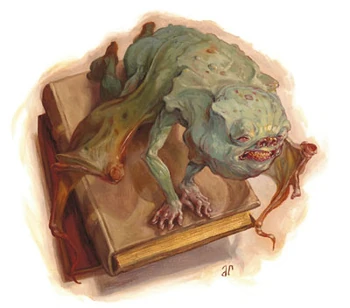 |
| Homonculus (3E) |



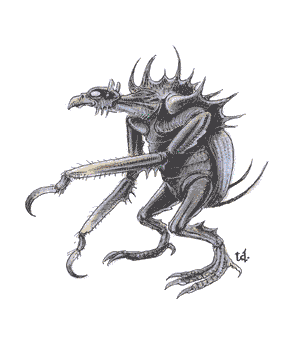 |
| 2E Hook Horror |
The Hook Horror is another one of my favourites as far as weird Underdark monstrosities go. Originally introduced in the 1st Edition's Fiend Folio, where some of the weirdest monsters in D&D hail from, the Hook Horror was initially just a huge muscle-bound rock dude with a weird bird's head and hooks for hands. Which evolved into the far, far cooler-looking creature in the 2nd Edition artwork, which made the Hook Horror a mixture of insect and bird parts. Look at that beetle-like carapace, those gangly insect-leg arms, the thin bird-head and the general weirdness of this creature! And then from 3E onwards we've basically had what became the enduring look of the Hook Horrors, with the little insect hooks becoming gigantic bony hook-arms, and the Hook Horror's main body given some muscles because it apparently worked out. I'm not the biggest fan of 3rd Edition's weird pose or the contorted bird-head, but subsequent editions -- 4E and 5E -- gives it a far more natural and bestial look. It's a massive turtle-bug-bird with giant bony claws for hands, and I really do like just how much more natural-looking the anatomy of the 5th Edition artwork looks... as natural-looking as the Hook Horror can look, anyway.
They live in caverns and can climb up walls, and apparently communicate in a language that involves scraping their hooks against their carapaces or something. And they're pack predators dedicated to their clan, and, well, intelligent enough to communicate. Interestingly, though, despite their horrifying appearance, hook horrors are noted to be omnivorous, so it's very much possible to meet a hook horror that just wants to disembowel you and your friends for today's meal, or for them to just be foragers looking for massive fungi forests. I really do like the Hook Horror. It's a pretty simple design of "slap a bunch of animals together (and also give it abs)", but it's definitely became a classic for a reason. It's not like my favourite monster by any means, but I sure do like it.

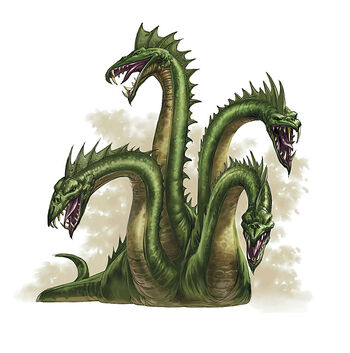
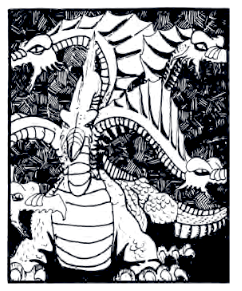
Hydra
Hail hydra! One of the last monsters we're going to talk about today is the good ol' hydra, yet another staple from Grecian mythology. And we all know what the Hydra is. Draconic body, multiple serpentine heads, cut of one head and two shall take its place. A typical 5E hydra has five heads, although of course, any GM could basically handwave a stronger or weaker hydra with adjectives. I do remember the 3.5E giving multiple stats for heads that are anywhere between five to twelve. They basically play on a lot of the hydra's common tropes. They can regrow their heads if they've been severed; they die only when all the heads are cut off; they live near water; they have a weakness to fire. Of course, with Tiamat being one of the most iconic characters in D&D, and Tiamat herself basically being a dragon-hydra, the hydra's backstory in 5E is tied to Tiamat, created from the cursed blood of another god that Tiamat slew. Although the hydra itself is noted to not be draconic in nature, rather being likened by the Monster Manual to a dinosaur or a crocodile. 4E's Hydra is actually far more serpentine, not even having any legs in its many, many appearances across the various monster manual.
A pretty awesome beast, and honestly, the legend of the hydra itself really does lend itself well into a boss fight in a game, doesn't it? Giant monster, multiple heads, you have to figure out a way to stop the heads from regenerating... Or, of course, you could do this. I really do like the Hydra. They show up enough in fiction to basically be one of the more common fantasy monsters out there, but shit, it's still pretty damn cool looking, y'know? In older editions, there are a lot of additional Hydra sub-types, in case you want to buff up your hydra. 3E had the Pyrohydra and Cryohydra, which had elemental powers, and 4E had elemental-plane hydras or something along those lines.
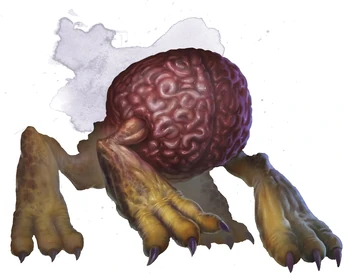
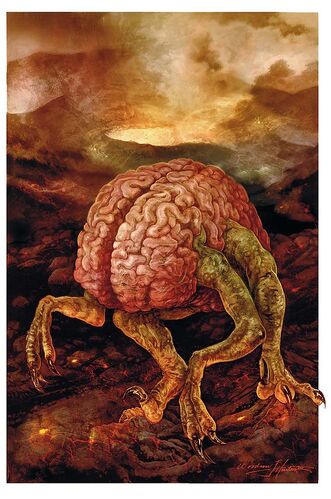

Intellect Devourer
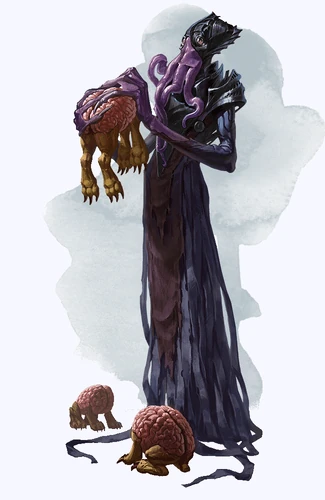 Oh god I love these things. We'll meet the Mind Flayers hopefully in the next "Reviewing D&D Monsters" segment or the one following that, but to those who completely have no idea what a Mind Flayer is... they're brain-eating psychic squid-faced people. And, of course, they keep little Intellect Devourers as what amounts to housepets. And the Intellect Devourers are giant brains with huge chunky dog legs! I really do love the huge chunky legs in the 1st edition artwork, although they grew more and more gangly and reptilian as the editions went on, culminating in a frankly bizarre looking one in the 4th edition where the creepy zombie gait is contrasted with the sheer absurdity of a brain with legs. And in the 5th edition, the Intellect Devourer gets its chunky beast legs back, and ooo what a good boy. Just look at that art piece from one of the D&D adventure modules, showing a Mind Flayer basically palling around with his little pets! They may be a reprehensible race of slavers and murderers, but they're good pet-parents! Even if they do create the pets out of the brains of their thralls and slaves.
Oh god I love these things. We'll meet the Mind Flayers hopefully in the next "Reviewing D&D Monsters" segment or the one following that, but to those who completely have no idea what a Mind Flayer is... they're brain-eating psychic squid-faced people. And, of course, they keep little Intellect Devourers as what amounts to housepets. And the Intellect Devourers are giant brains with huge chunky dog legs! I really do love the huge chunky legs in the 1st edition artwork, although they grew more and more gangly and reptilian as the editions went on, culminating in a frankly bizarre looking one in the 4th edition where the creepy zombie gait is contrasted with the sheer absurdity of a brain with legs. And in the 5th edition, the Intellect Devourer gets its chunky beast legs back, and ooo what a good boy. Just look at that art piece from one of the D&D adventure modules, showing a Mind Flayer basically palling around with his little pets! They may be a reprehensible race of slavers and murderers, but they're good pet-parents! Even if they do create the pets out of the brains of their thralls and slaves.
Intellect Devourers are, well, psychic creatures, just like their masters, and they literally feed on the intelligence of sentient creatures. Literally! They straight-up eat the "Intelligence" portion of your stat block, making you dumber and dumber and eventually losing actual memories and your sense of self, and the end-stage of an Intellect Devourer's attack is to be transformed into a puppet under the little brain-pupper's control. Alone, they're not that harmful and you can probably figure out how to punt the walking brain-puppers away, but when they're just running around while you're fighting a bunch of their far more deadly masters? Honestly, one of the simultaneously whimsical-looking and terrifying-when-you-think-about-it creatures in this book.
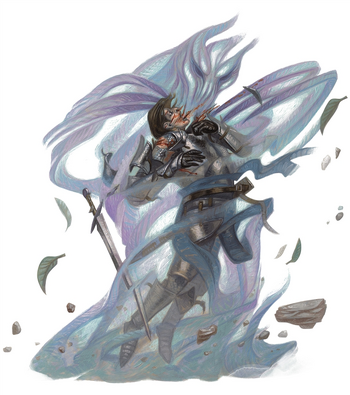
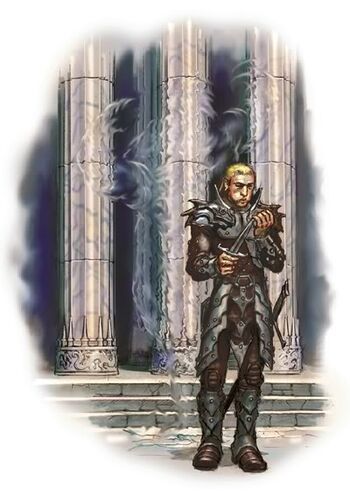
Invisible Stalker
The Invisible Stalker shows up in practically every edition, and it's... honestly kind of just there? Sometimes you want an invisible enemy that's not a ghost or a specter or a wraith or a shade, so you go for the Invisible Stalker, which is a specialized air elemental that's summoned and given a task to hunt down foes and/or retrieve objects. It's basically a soulless being that's bound to the magic that created it to form its task, and, like golems and whatnot, it's one of those monsters who takes its orders literally. A neat opponent to face in a campaign, but ultimately, kinda boring. The most memorable thing about the Invisible Stalker for me was that the 2E Monstrous Manual quite literally had an empty white box where the monster's artwork should be.
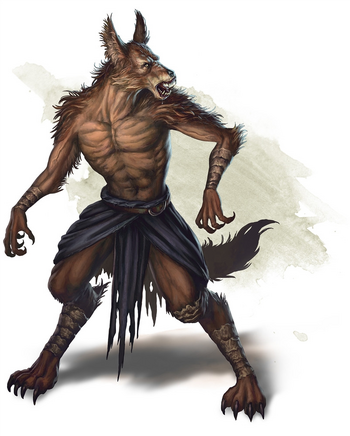
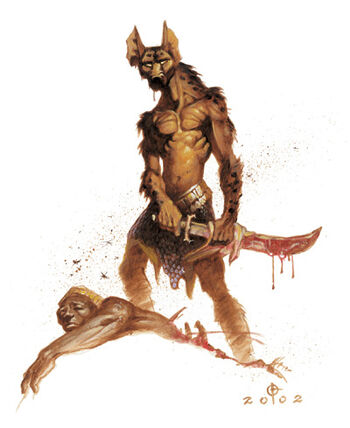
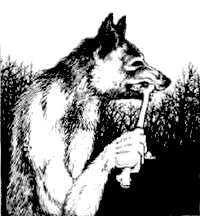
Jackalwere
There is a significant amount of 'were-X' in D&D, and we have massive chunks of differing Monster Manuals detailing lycanthropes. Werewolves, werebears, wereboars, wererats, werebats, weresharks... they are all humanoids transformed into a half-man, half-animal state. The Jackalwere, as its naming convention shows, is the exact opposite. It's an intelligent jackal in its natural state that can transform into a half-humanoid state or a fully-human state, and they're created out of some foul demonic ritual by the demon lord Graz'zt. And they often pose as ragged travelers begging for aid, but when some traveling band welcomes the jackalwere into their midst, it transforms into its true, half-bestial, half-man form to attack. They tend to be the minions of Lamias (another monster we'll cover eventually), and it's basically a perversion of the whole "be a good Samaritan and help people in need" thing. Because of course the asshole demons in this world will make use of exactly that to cause slaughter and whatnot. Also, they've got a sleep-inducing gaze... just because? I'm not sure if it's an actual superstition people have for jackals or not. I'm perhaps the biggest fan of the Jackalwere's 3rd Edition artwork, which just looks so gaunt and threatening. Overall, probably not my favourite monster out there, but one that's pretty neat enough with its own modus operandi that it does fit well as a potential antagonist.

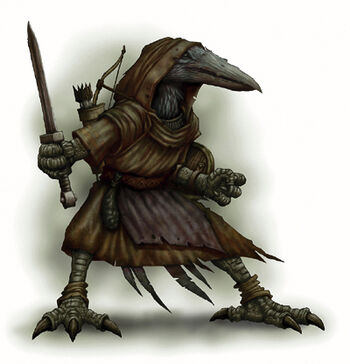
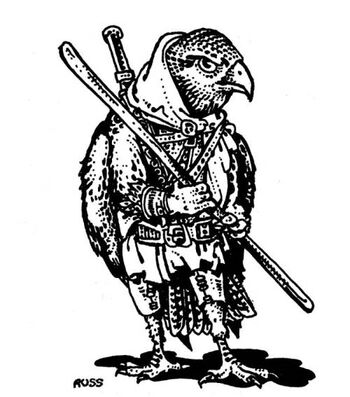
Kenku
I've always had an inordinate amount of love for the Kenku race as a whole, even though normally, I tend to be ambivalent about bird monsters. There's just something about a race of grubby little scavenging crow-men that apparently is incapable of original thought and steals everything from other races makes me really like them, y'know? It's actually surprising for me to learn that the Kenku has been aroud since the first edition's Fiend Folio, because I genuinely don't remember them showing up in the editions I've played. I'm not sure if my memory's just spotty, or if they didn't receive a lot of their more interesting fluff until 5E. It's pretty interesting, too, how the Kenku technically is pretty much just a short humanoid with a bird's head and feet, but ends up being a lot more memorable to me than the Aarakocra or Harpy. I guess it's the personality of their race as a whole?
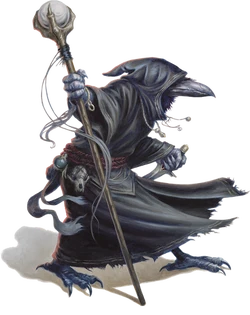 The Kenku are characterized as greedy vagabonds that sort of imitate and reproduce any sound they hear, and use this to basically trick and run scams to get, and while originally conceptualized as a generic bird-man, in all post-3E art they've been given a crow or raven bent. My GM tends to house-rule Kenku as being able to have the features of any bird out there because he's a bit of an biology geek -- a practice he repeats with Triton, Tabaxi, Thri-kreen and Lizardfolk NPC's. But by and by, the Kenku race as a whole in official D&D does tend to lean more towards being based on the cultural depiction of greedy, scavenging ravens. I do love the little backstory about how they once were a race of winged bird-people who served a god-like being (either Graz'zt or a Wind-lord or something, but left deliberately vague so your GM can fill in the details for your campaign) that cursed them due to their attempts to steal a particularly valuable trinket from their master. Kind of biblical, actually! The original Monster Manual doesn't really give us all that much, and the Kenku ends up feeling interesting but gimmicky, with every line devoted to them just highlighting how they like to mimic voices but are ultimately glorified grifters.
The Kenku are characterized as greedy vagabonds that sort of imitate and reproduce any sound they hear, and use this to basically trick and run scams to get, and while originally conceptualized as a generic bird-man, in all post-3E art they've been given a crow or raven bent. My GM tends to house-rule Kenku as being able to have the features of any bird out there because he's a bit of an biology geek -- a practice he repeats with Triton, Tabaxi, Thri-kreen and Lizardfolk NPC's. But by and by, the Kenku race as a whole in official D&D does tend to lean more towards being based on the cultural depiction of greedy, scavenging ravens. I do love the little backstory about how they once were a race of winged bird-people who served a god-like being (either Graz'zt or a Wind-lord or something, but left deliberately vague so your GM can fill in the details for your campaign) that cursed them due to their attempts to steal a particularly valuable trinket from their master. Kind of biblical, actually! The original Monster Manual doesn't really give us all that much, and the Kenku ends up feeling interesting but gimmicky, with every line devoted to them just highlighting how they like to mimic voices but are ultimately glorified grifters.
And then, of course, Volo's Guide to Monsters, essentially 5th Edition's second Monster Manual, unexpectedly gave a whole section to the Kenku, highlighting them as one of the races that players could pick as a playable character. And since they were considered 'chaotic neutral' even when they were antagonists... hurray! The Kenku are noted to actually be unable to properly form words thanks to this curse, and while they certainly can communicate with their fellow Kenku with bird noises, a Kenku had to slowly listen and develop a 'library' of phrases that he or she has heard from people around. Sort of like Bumblebee from the Transformers movies -- although obviously, in an actual GM-and-player setting, some leeway has to be done. This 'hopeless plagiarism' and their simple desire to take flight ends up putting a sad spin on what was once a ha-ha-look-at-this-dumb-race that was more gimmick-driven. It's not that they're lazy, greedy, grubby bastards, they are literally cursed by a godlike being to be unable to make a properly original thought -- they're very skilled in actually replicating things they've already seen, or to generally just sneak aroud and observe, but can't actually improvize. I actually ended up being so enamoured with this strange, strange creature and ended up playing as a Kenku character for a while, and it's such an interestingly different sensation to play a communication-impaired character.
The 5E stats for the monsters covered here. Like the 'dracolich' template, the 'half-dragon' template could be given to any humanoid.



Hydra
Hail hydra! One of the last monsters we're going to talk about today is the good ol' hydra, yet another staple from Grecian mythology. And we all know what the Hydra is. Draconic body, multiple serpentine heads, cut of one head and two shall take its place. A typical 5E hydra has five heads, although of course, any GM could basically handwave a stronger or weaker hydra with adjectives. I do remember the 3.5E giving multiple stats for heads that are anywhere between five to twelve. They basically play on a lot of the hydra's common tropes. They can regrow their heads if they've been severed; they die only when all the heads are cut off; they live near water; they have a weakness to fire. Of course, with Tiamat being one of the most iconic characters in D&D, and Tiamat herself basically being a dragon-hydra, the hydra's backstory in 5E is tied to Tiamat, created from the cursed blood of another god that Tiamat slew. Although the hydra itself is noted to not be draconic in nature, rather being likened by the Monster Manual to a dinosaur or a crocodile. 4E's Hydra is actually far more serpentine, not even having any legs in its many, many appearances across the various monster manual.
A pretty awesome beast, and honestly, the legend of the hydra itself really does lend itself well into a boss fight in a game, doesn't it? Giant monster, multiple heads, you have to figure out a way to stop the heads from regenerating... Or, of course, you could do this. I really do like the Hydra. They show up enough in fiction to basically be one of the more common fantasy monsters out there, but shit, it's still pretty damn cool looking, y'know? In older editions, there are a lot of additional Hydra sub-types, in case you want to buff up your hydra. 3E had the Pyrohydra and Cryohydra, which had elemental powers, and 4E had elemental-plane hydras or something along those lines.



Intellect Devourer
 Oh god I love these things. We'll meet the Mind Flayers hopefully in the next "Reviewing D&D Monsters" segment or the one following that, but to those who completely have no idea what a Mind Flayer is... they're brain-eating psychic squid-faced people. And, of course, they keep little Intellect Devourers as what amounts to housepets. And the Intellect Devourers are giant brains with huge chunky dog legs! I really do love the huge chunky legs in the 1st edition artwork, although they grew more and more gangly and reptilian as the editions went on, culminating in a frankly bizarre looking one in the 4th edition where the creepy zombie gait is contrasted with the sheer absurdity of a brain with legs. And in the 5th edition, the Intellect Devourer gets its chunky beast legs back, and ooo what a good boy. Just look at that art piece from one of the D&D adventure modules, showing a Mind Flayer basically palling around with his little pets! They may be a reprehensible race of slavers and murderers, but they're good pet-parents! Even if they do create the pets out of the brains of their thralls and slaves.
Oh god I love these things. We'll meet the Mind Flayers hopefully in the next "Reviewing D&D Monsters" segment or the one following that, but to those who completely have no idea what a Mind Flayer is... they're brain-eating psychic squid-faced people. And, of course, they keep little Intellect Devourers as what amounts to housepets. And the Intellect Devourers are giant brains with huge chunky dog legs! I really do love the huge chunky legs in the 1st edition artwork, although they grew more and more gangly and reptilian as the editions went on, culminating in a frankly bizarre looking one in the 4th edition where the creepy zombie gait is contrasted with the sheer absurdity of a brain with legs. And in the 5th edition, the Intellect Devourer gets its chunky beast legs back, and ooo what a good boy. Just look at that art piece from one of the D&D adventure modules, showing a Mind Flayer basically palling around with his little pets! They may be a reprehensible race of slavers and murderers, but they're good pet-parents! Even if they do create the pets out of the brains of their thralls and slaves.Intellect Devourers are, well, psychic creatures, just like their masters, and they literally feed on the intelligence of sentient creatures. Literally! They straight-up eat the "Intelligence" portion of your stat block, making you dumber and dumber and eventually losing actual memories and your sense of self, and the end-stage of an Intellect Devourer's attack is to be transformed into a puppet under the little brain-pupper's control. Alone, they're not that harmful and you can probably figure out how to punt the walking brain-puppers away, but when they're just running around while you're fighting a bunch of their far more deadly masters? Honestly, one of the simultaneously whimsical-looking and terrifying-when-you-think-about-it creatures in this book.


Invisible Stalker
The Invisible Stalker shows up in practically every edition, and it's... honestly kind of just there? Sometimes you want an invisible enemy that's not a ghost or a specter or a wraith or a shade, so you go for the Invisible Stalker, which is a specialized air elemental that's summoned and given a task to hunt down foes and/or retrieve objects. It's basically a soulless being that's bound to the magic that created it to form its task, and, like golems and whatnot, it's one of those monsters who takes its orders literally. A neat opponent to face in a campaign, but ultimately, kinda boring. The most memorable thing about the Invisible Stalker for me was that the 2E Monstrous Manual quite literally had an empty white box where the monster's artwork should be.



Jackalwere
There is a significant amount of 'were-X' in D&D, and we have massive chunks of differing Monster Manuals detailing lycanthropes. Werewolves, werebears, wereboars, wererats, werebats, weresharks... they are all humanoids transformed into a half-man, half-animal state. The Jackalwere, as its naming convention shows, is the exact opposite. It's an intelligent jackal in its natural state that can transform into a half-humanoid state or a fully-human state, and they're created out of some foul demonic ritual by the demon lord Graz'zt. And they often pose as ragged travelers begging for aid, but when some traveling band welcomes the jackalwere into their midst, it transforms into its true, half-bestial, half-man form to attack. They tend to be the minions of Lamias (another monster we'll cover eventually), and it's basically a perversion of the whole "be a good Samaritan and help people in need" thing. Because of course the asshole demons in this world will make use of exactly that to cause slaughter and whatnot. Also, they've got a sleep-inducing gaze... just because? I'm not sure if it's an actual superstition people have for jackals or not. I'm perhaps the biggest fan of the Jackalwere's 3rd Edition artwork, which just looks so gaunt and threatening. Overall, probably not my favourite monster out there, but one that's pretty neat enough with its own modus operandi that it does fit well as a potential antagonist.



Kenku
I've always had an inordinate amount of love for the Kenku race as a whole, even though normally, I tend to be ambivalent about bird monsters. There's just something about a race of grubby little scavenging crow-men that apparently is incapable of original thought and steals everything from other races makes me really like them, y'know? It's actually surprising for me to learn that the Kenku has been aroud since the first edition's Fiend Folio, because I genuinely don't remember them showing up in the editions I've played. I'm not sure if my memory's just spotty, or if they didn't receive a lot of their more interesting fluff until 5E. It's pretty interesting, too, how the Kenku technically is pretty much just a short humanoid with a bird's head and feet, but ends up being a lot more memorable to me than the Aarakocra or Harpy. I guess it's the personality of their race as a whole?
 The Kenku are characterized as greedy vagabonds that sort of imitate and reproduce any sound they hear, and use this to basically trick and run scams to get, and while originally conceptualized as a generic bird-man, in all post-3E art they've been given a crow or raven bent. My GM tends to house-rule Kenku as being able to have the features of any bird out there because he's a bit of an biology geek -- a practice he repeats with Triton, Tabaxi, Thri-kreen and Lizardfolk NPC's. But by and by, the Kenku race as a whole in official D&D does tend to lean more towards being based on the cultural depiction of greedy, scavenging ravens. I do love the little backstory about how they once were a race of winged bird-people who served a god-like being (either Graz'zt or a Wind-lord or something, but left deliberately vague so your GM can fill in the details for your campaign) that cursed them due to their attempts to steal a particularly valuable trinket from their master. Kind of biblical, actually! The original Monster Manual doesn't really give us all that much, and the Kenku ends up feeling interesting but gimmicky, with every line devoted to them just highlighting how they like to mimic voices but are ultimately glorified grifters.
The Kenku are characterized as greedy vagabonds that sort of imitate and reproduce any sound they hear, and use this to basically trick and run scams to get, and while originally conceptualized as a generic bird-man, in all post-3E art they've been given a crow or raven bent. My GM tends to house-rule Kenku as being able to have the features of any bird out there because he's a bit of an biology geek -- a practice he repeats with Triton, Tabaxi, Thri-kreen and Lizardfolk NPC's. But by and by, the Kenku race as a whole in official D&D does tend to lean more towards being based on the cultural depiction of greedy, scavenging ravens. I do love the little backstory about how they once were a race of winged bird-people who served a god-like being (either Graz'zt or a Wind-lord or something, but left deliberately vague so your GM can fill in the details for your campaign) that cursed them due to their attempts to steal a particularly valuable trinket from their master. Kind of biblical, actually! The original Monster Manual doesn't really give us all that much, and the Kenku ends up feeling interesting but gimmicky, with every line devoted to them just highlighting how they like to mimic voices but are ultimately glorified grifters.And then, of course, Volo's Guide to Monsters, essentially 5th Edition's second Monster Manual, unexpectedly gave a whole section to the Kenku, highlighting them as one of the races that players could pick as a playable character. And since they were considered 'chaotic neutral' even when they were antagonists... hurray! The Kenku are noted to actually be unable to properly form words thanks to this curse, and while they certainly can communicate with their fellow Kenku with bird noises, a Kenku had to slowly listen and develop a 'library' of phrases that he or she has heard from people around. Sort of like Bumblebee from the Transformers movies -- although obviously, in an actual GM-and-player setting, some leeway has to be done. This 'hopeless plagiarism' and their simple desire to take flight ends up putting a sad spin on what was once a ha-ha-look-at-this-dumb-race that was more gimmick-driven. It's not that they're lazy, greedy, grubby bastards, they are literally cursed by a godlike being to be unable to make a properly original thought -- they're very skilled in actually replicating things they've already seen, or to generally just sneak aroud and observe, but can't actually improvize. I actually ended up being so enamoured with this strange, strange creature and ended up playing as a Kenku character for a while, and it's such an interestingly different sensation to play a communication-impaired character.
The 5E stats for the monsters covered here. Like the 'dracolich' template, the 'half-dragon' template could be given to any humanoid.
- Snirfneblin: Small humanoid - gnome; neutral good; CR 1/2
- Goblin: Small humanoid - goblinoid; neutral evil; CR 1/4
- Goblin Boss: Small humanoid - goblinoid; neutral evil; CR 1
- Clay Golem: Large construct; unaligned; CR 9
- Flesh Golem: Medium construct; neutral; CR 5
- Iron Golem: Large construct; unaligned; CR 16
- Stone Golem: Large construct; unaligned; CR 10
- Gorgon: Large monstrosity; unaligned; CR 5
- Grell: Medium aberration; neutral evil; CR 3
- Grick: Medium monstrosity; neutral; CR 2
- Grick Alpha: Large monstrosity; neutral; CR 7
- Griffon: Large monstrosity; unaligned; CR 2
- Grimlock: Medium humanoid - grimlock; neutral evil; CR 1/4
- Green Hag: Medium fey; neutral evil; CR 3, all hags get a +2 CR when part of a coven.
- Night Hag: Medium fiend; neutral evil; CR 5
- Sea Hag: Medium fey; chaotic evil; CR 2
- Half-Red-Dragon Veteran: Medium humanoid - human; any alignment; CR 5
- Harpy: Medium monstrosity; chaotic evil; CR 1
- Hell Hound: Medium fiend; lawful evil; CR 3
- Helmed Horror: Medium construct; neutral; CR 4
- Hippogriff: Large monstrosity; unaligned; CR 1
- Hobgoblin: Medium humanoid - goblinoid; lawful evil; CR 1/2
- Hobgoblin Captain: Medium humanoid - goblinoid; lawful evil; CR 3
- Hobgoblin Warlord: Medium humanoid - goblinoid; lawful evil; CR 6
- Homonculus: Tiny construct; neutral; CR 0
- Hook Horror: Large monstrosity; neutral; CR 3
- Hydra: Large monstrosity; unaligned; CR 8
- Intellect Devourer: Tiny aberration; lawful evil; CR 2
- Invisible Stalker: Medium elemental; neutral; CR 6
- Jackalwere: Medium humanoid shapechanger; chaotic evil; CR 1/2
- Kenku: Medium humanoid - kenku; chaotic neutral; CR 1/4
That's the article Reviewing D&D Monsters - 5E Monster Manual, Goblins to Kenku
That's it for the article Reviewing D&D Monsters - 5E Monster Manual, Goblins to Kenku this time, hopefully can be useful for all of you. okay, see you in another article post.
You are now reading the article Reviewing D&D Monsters - 5E Monster Manual, Goblins to Kenku with link address https://kanakoroku.blogspot.com/2019/11/reviewing-d-monsters-5e-monster-manual_4.html
